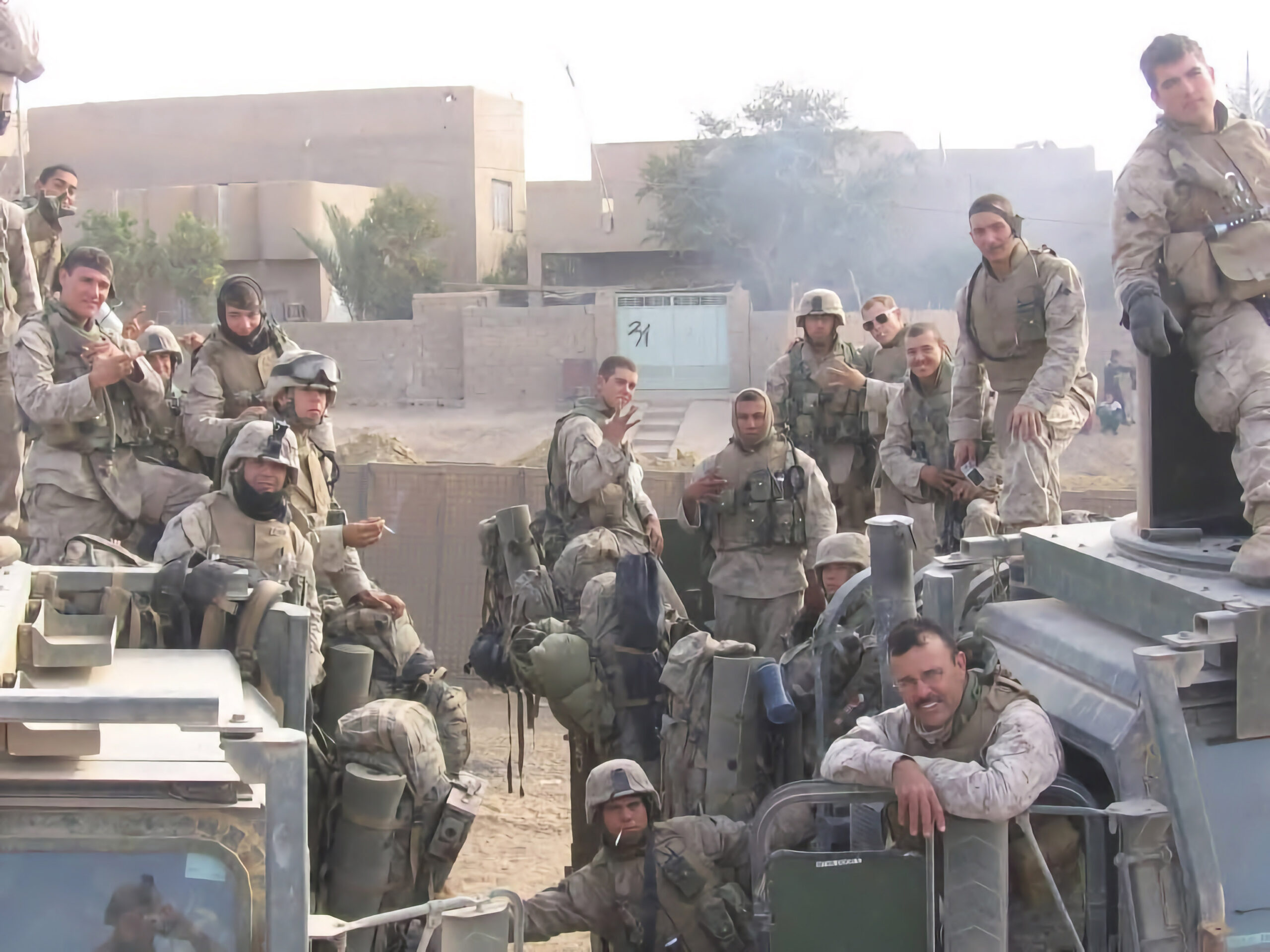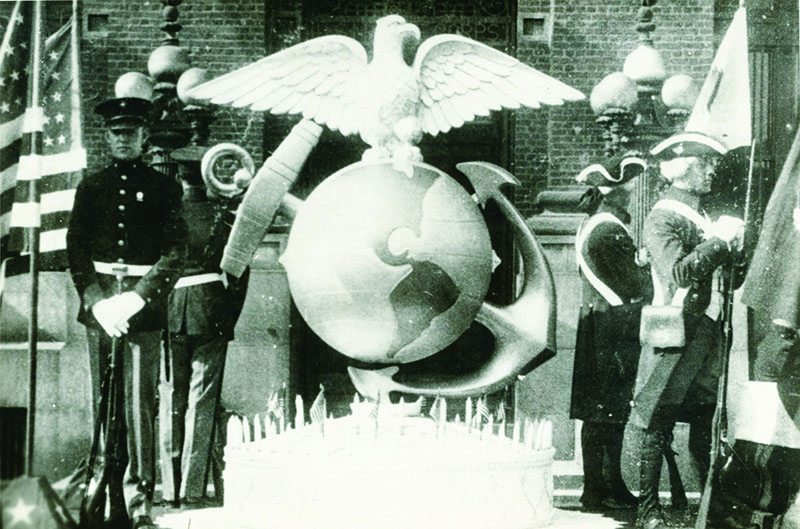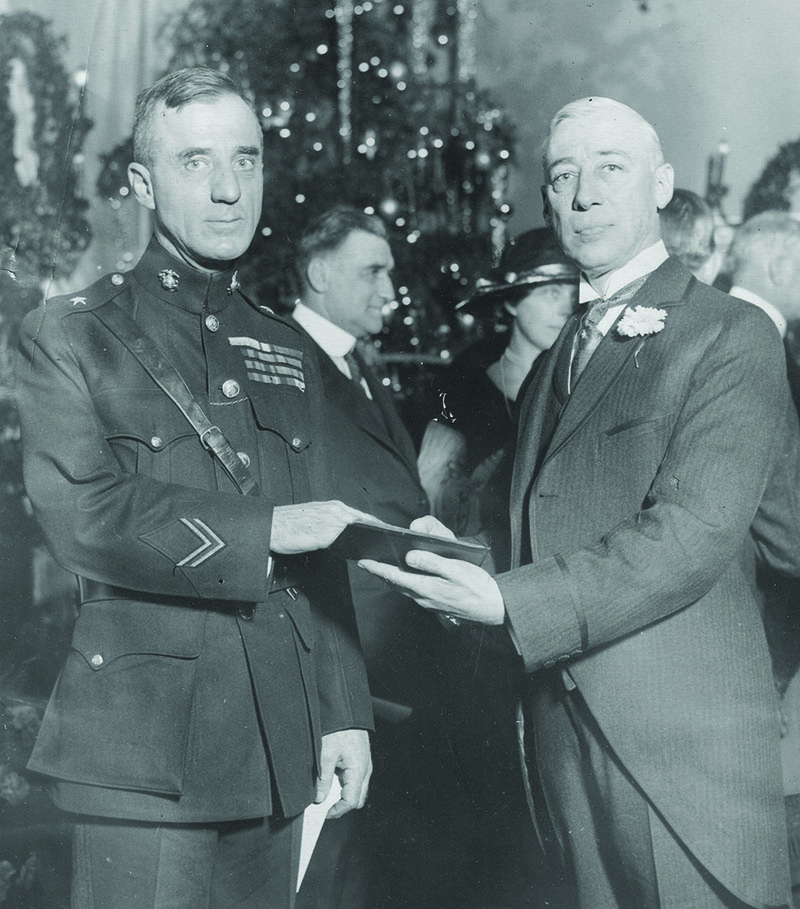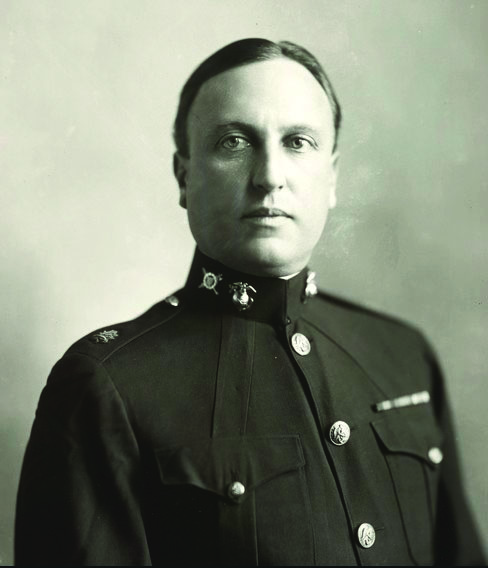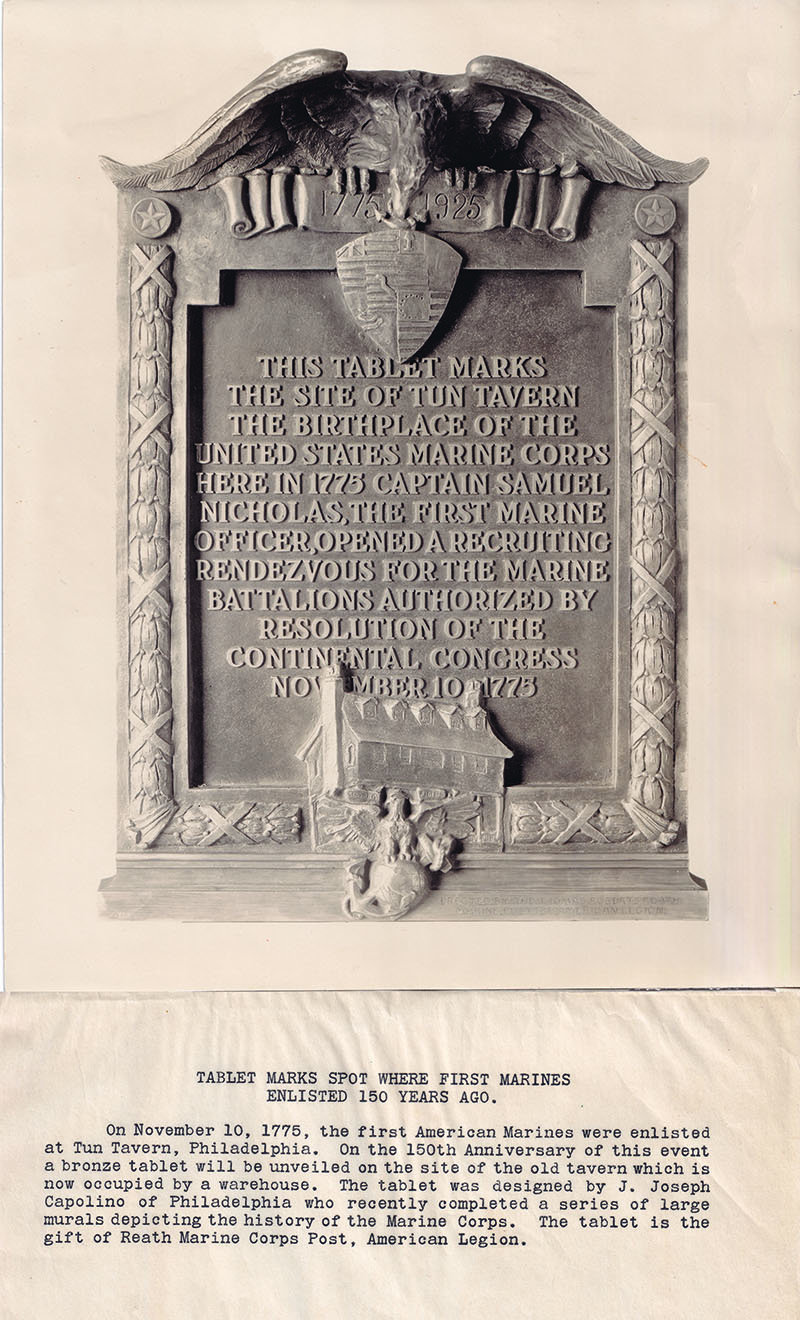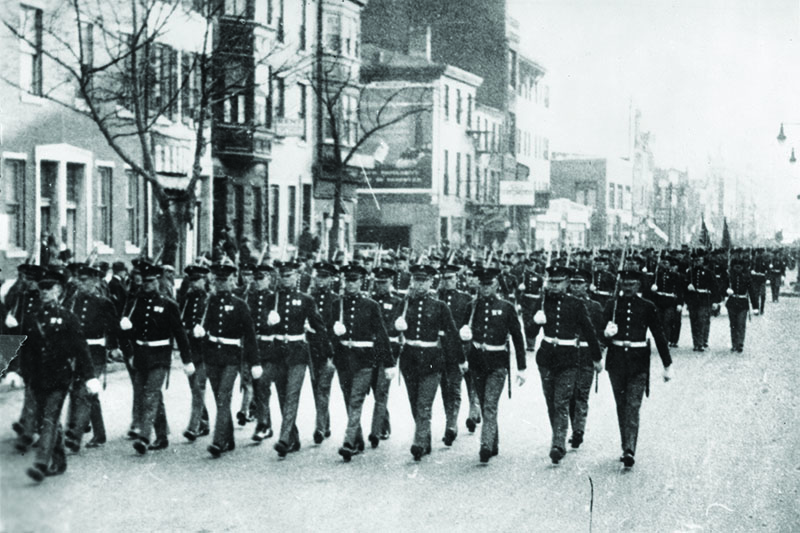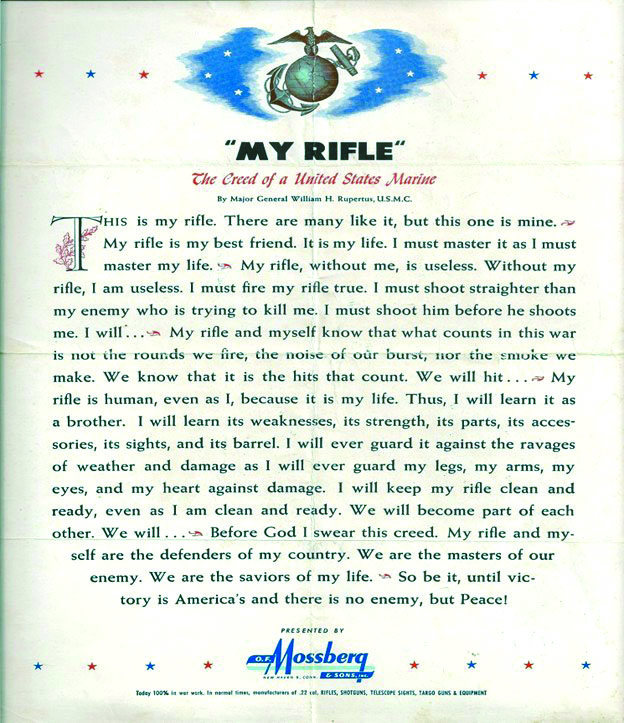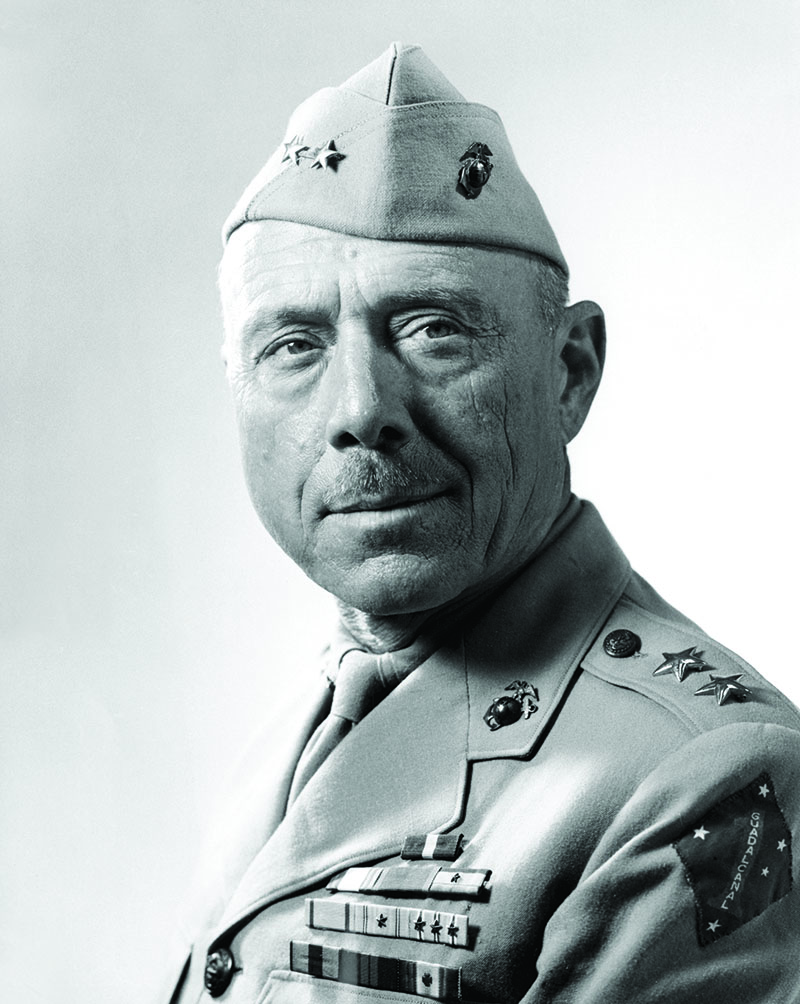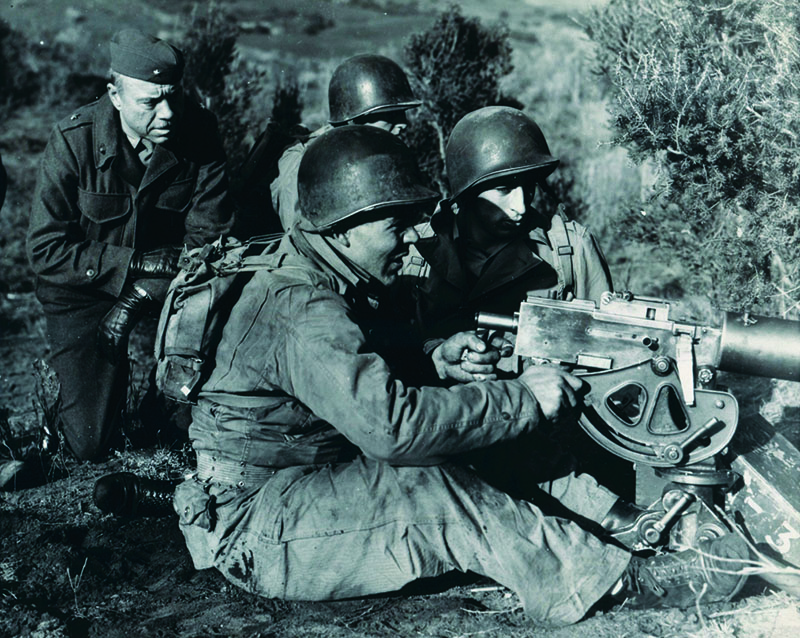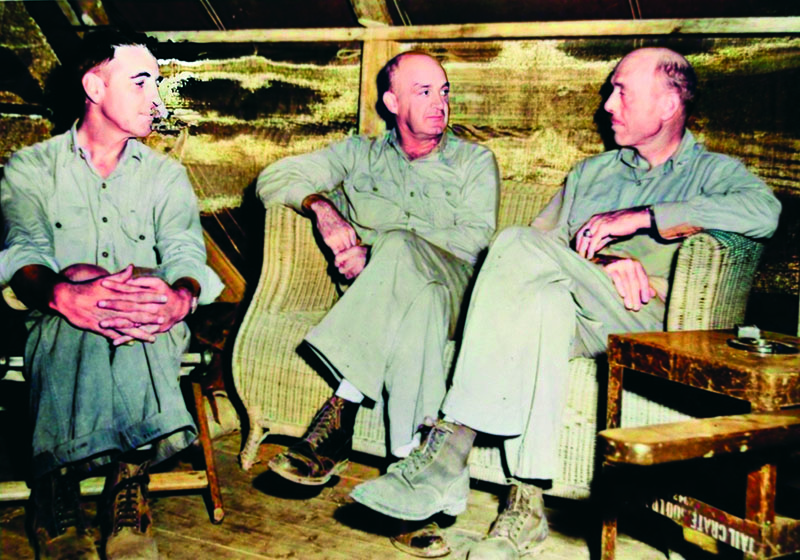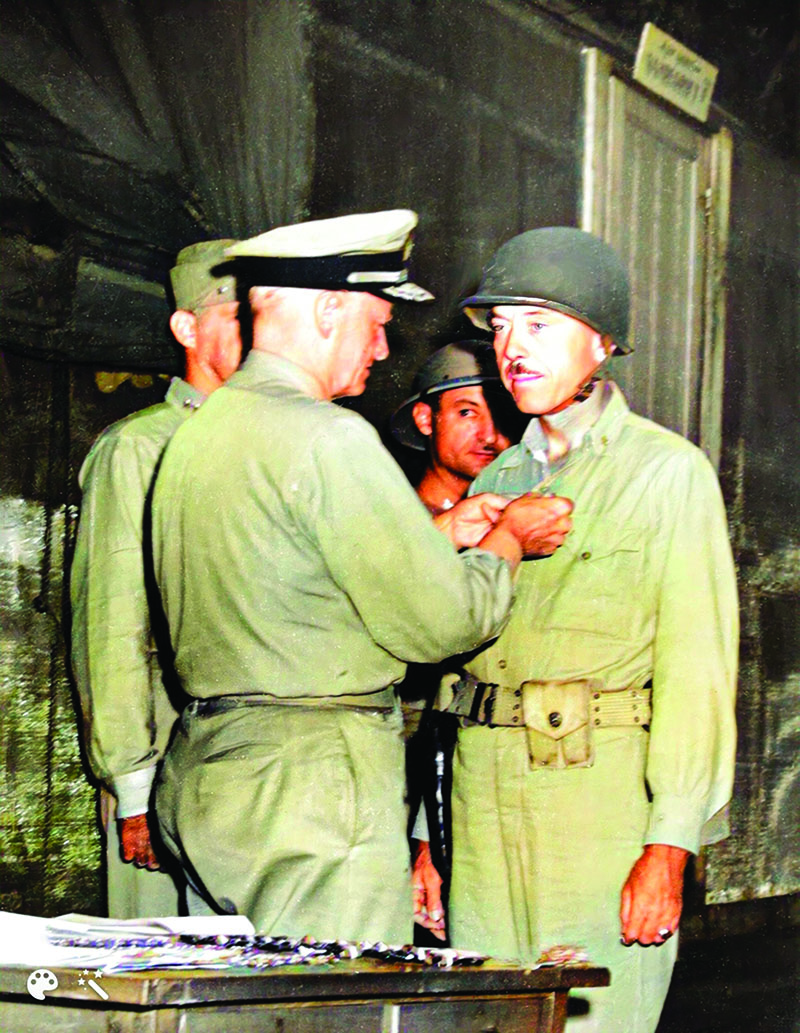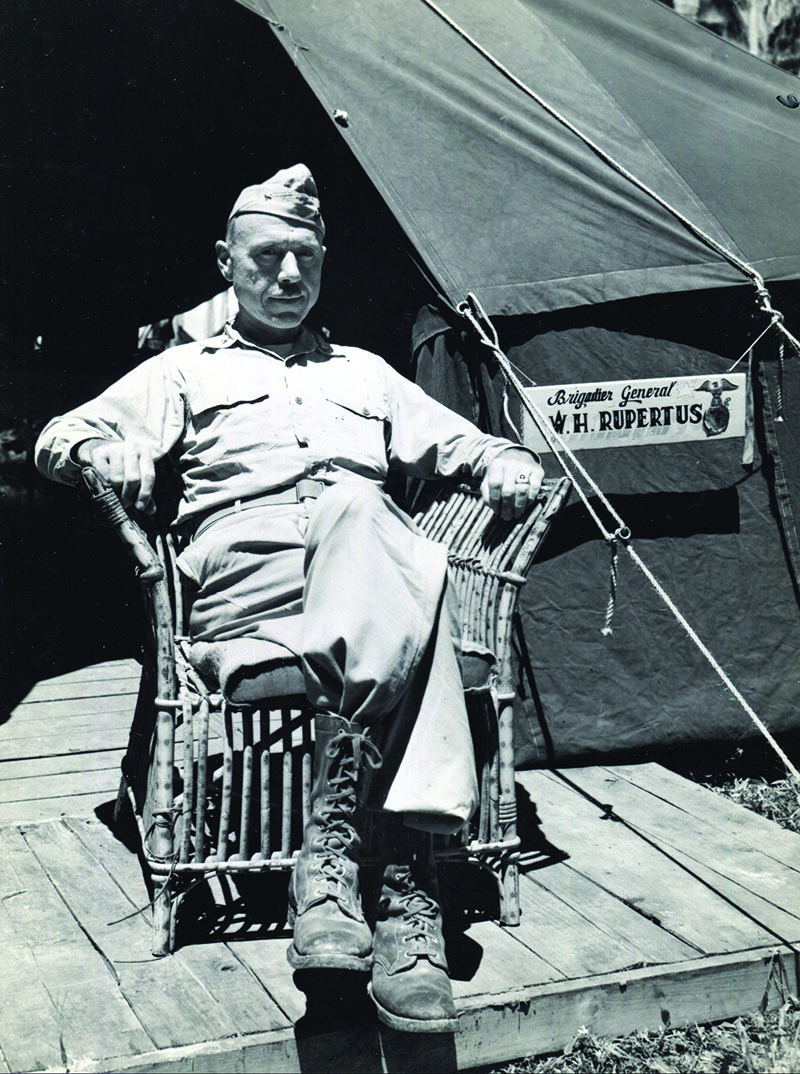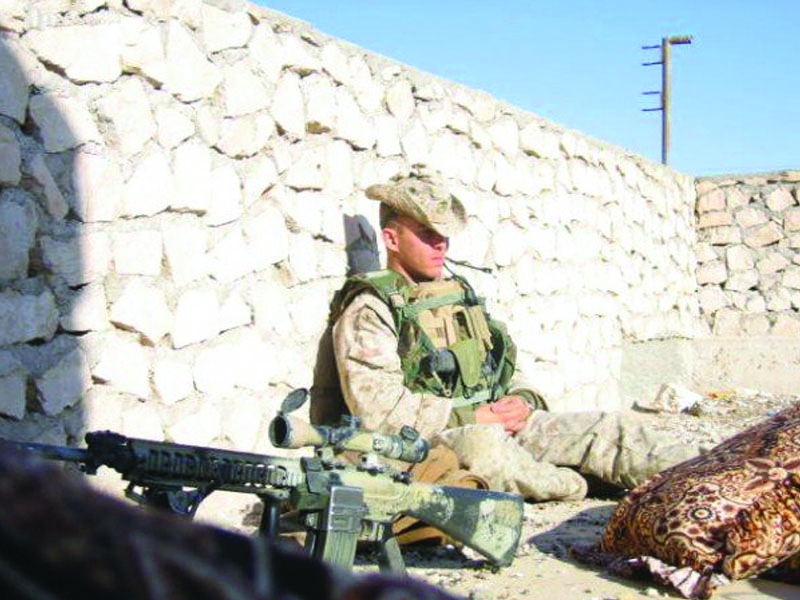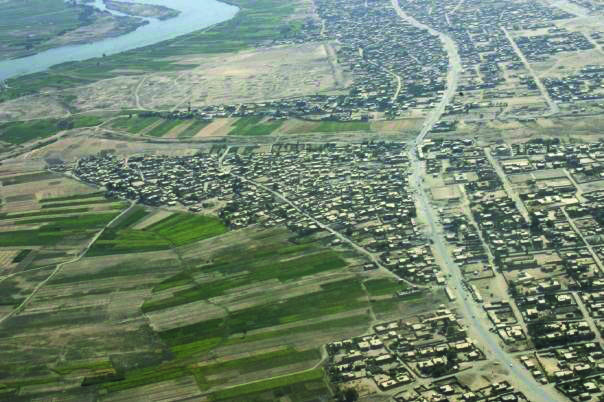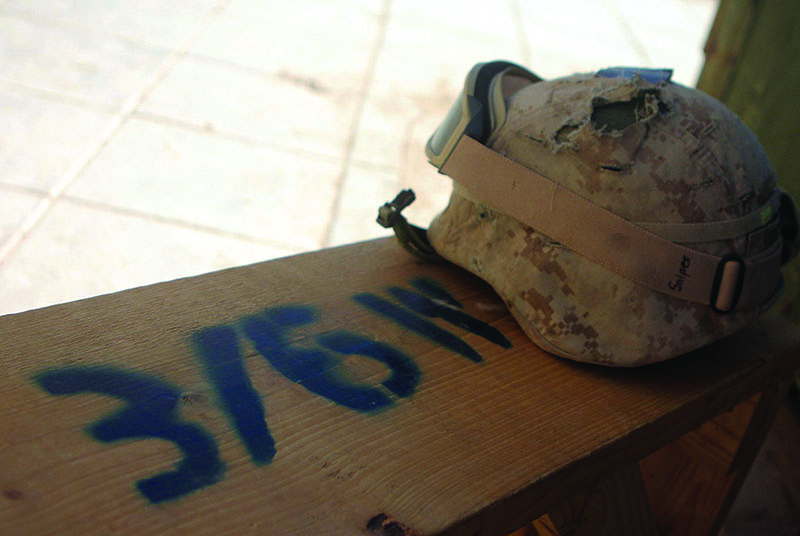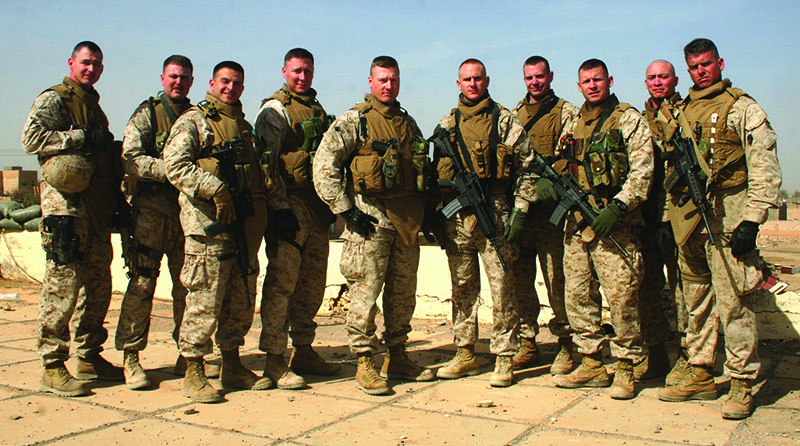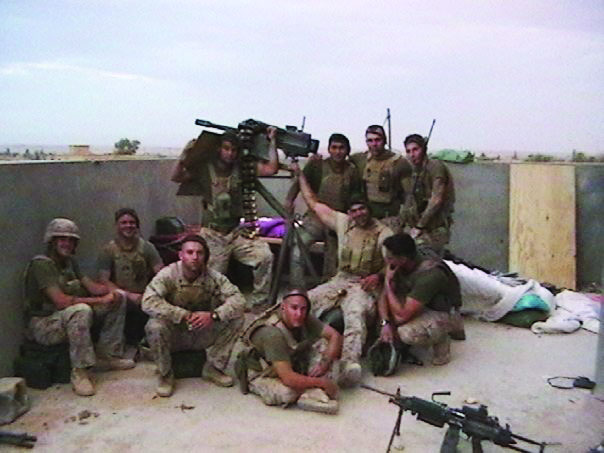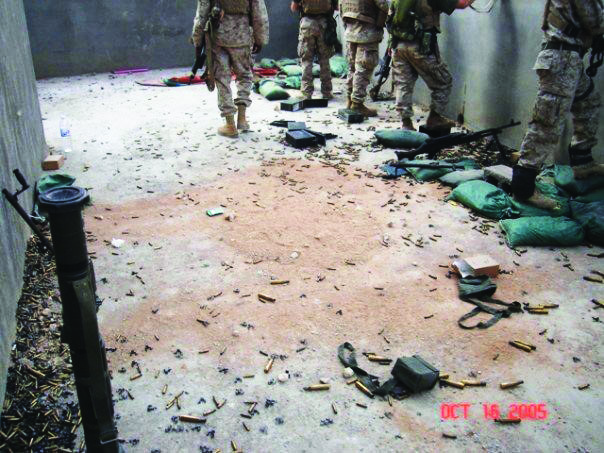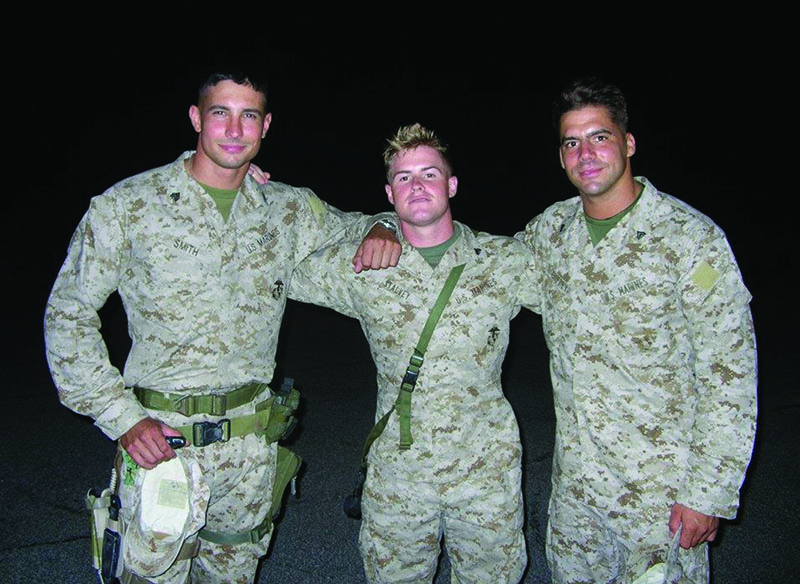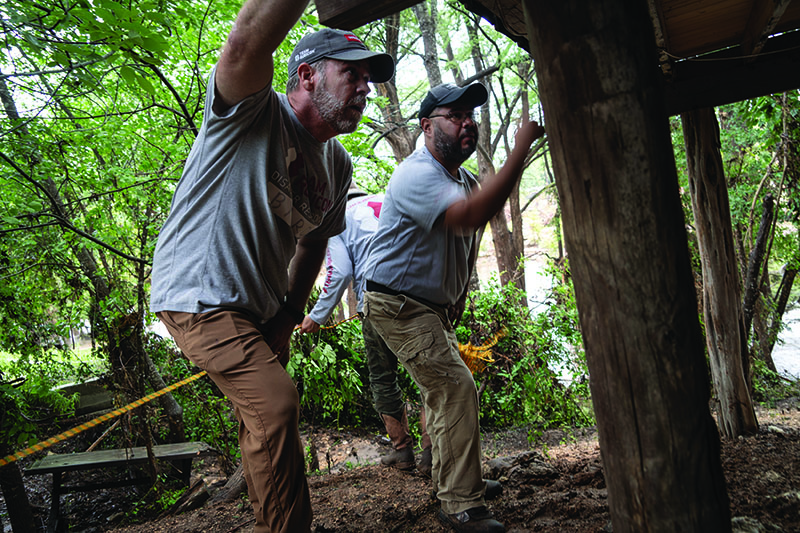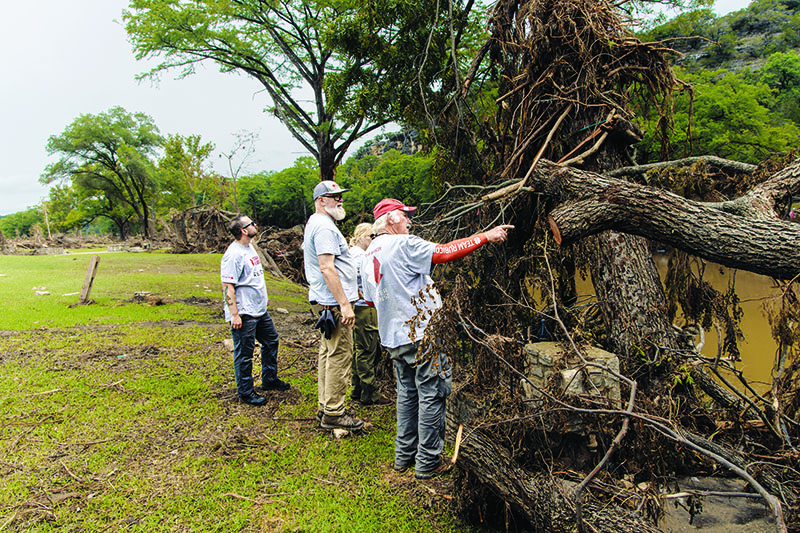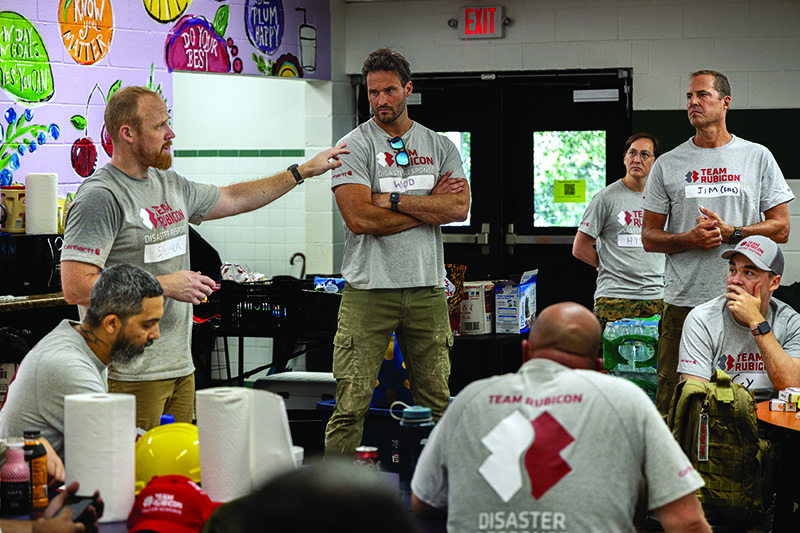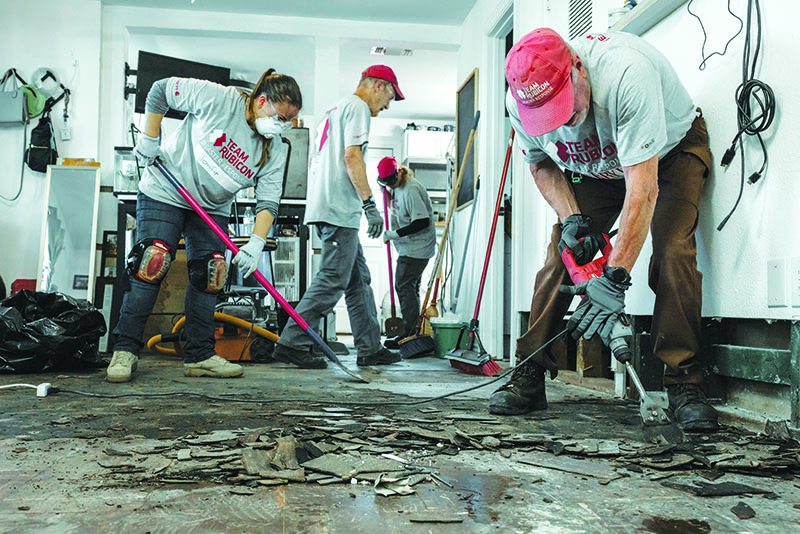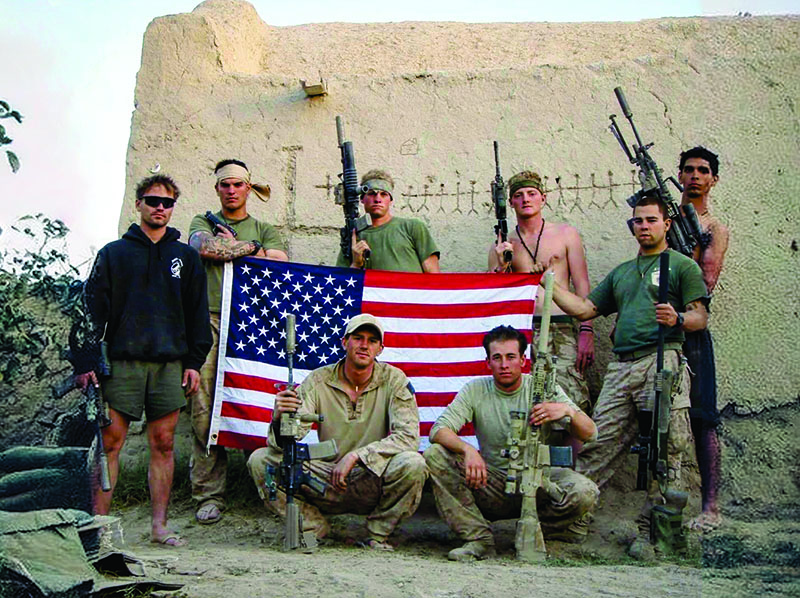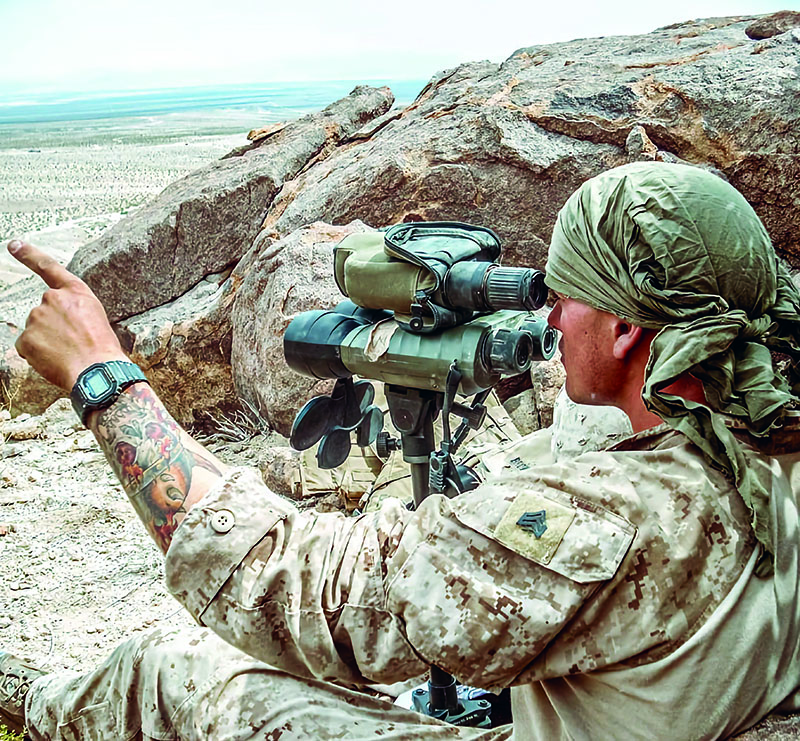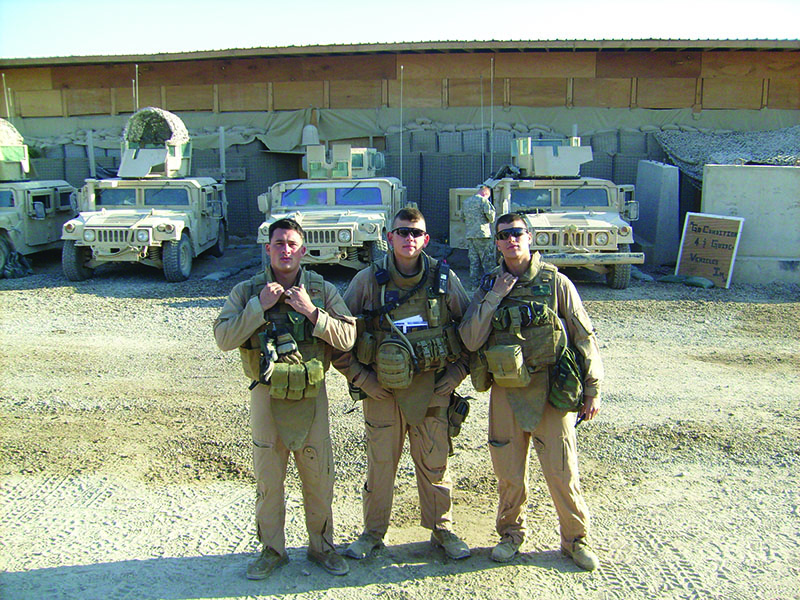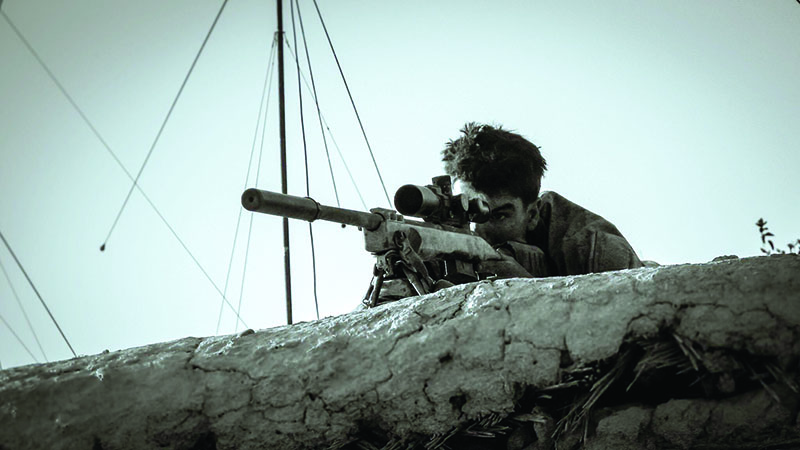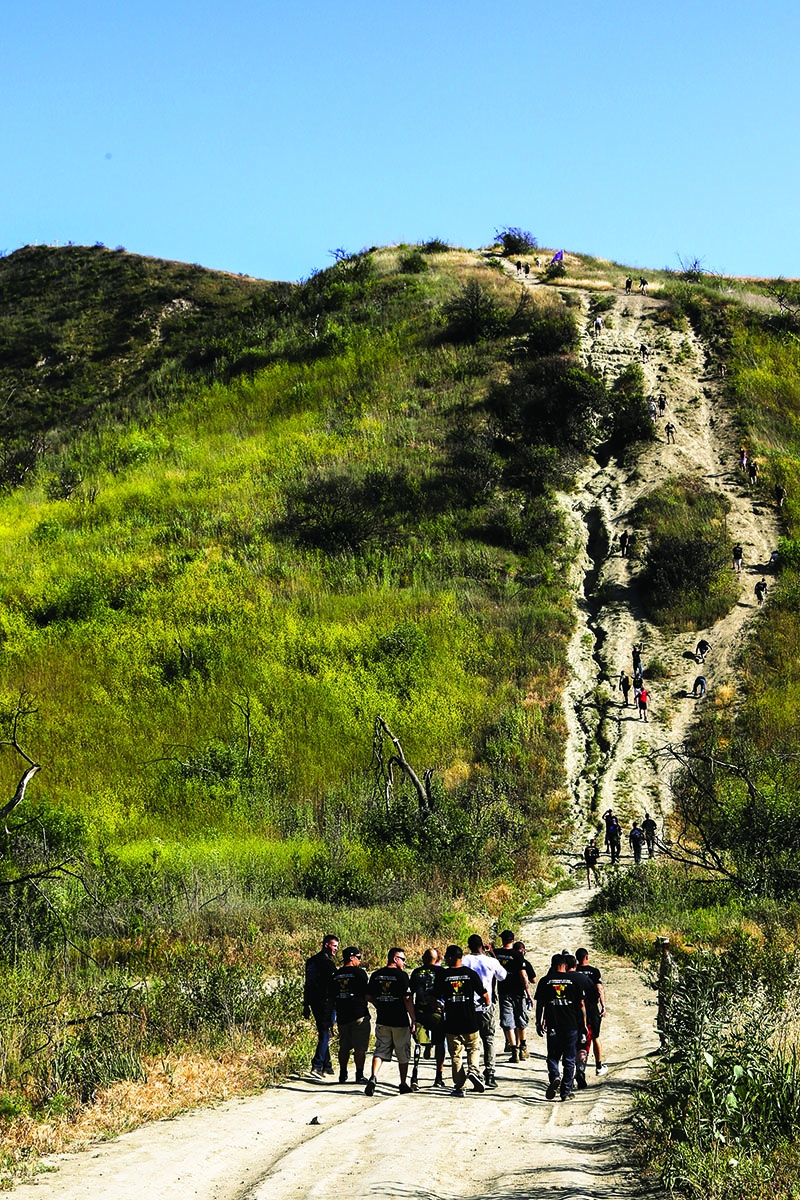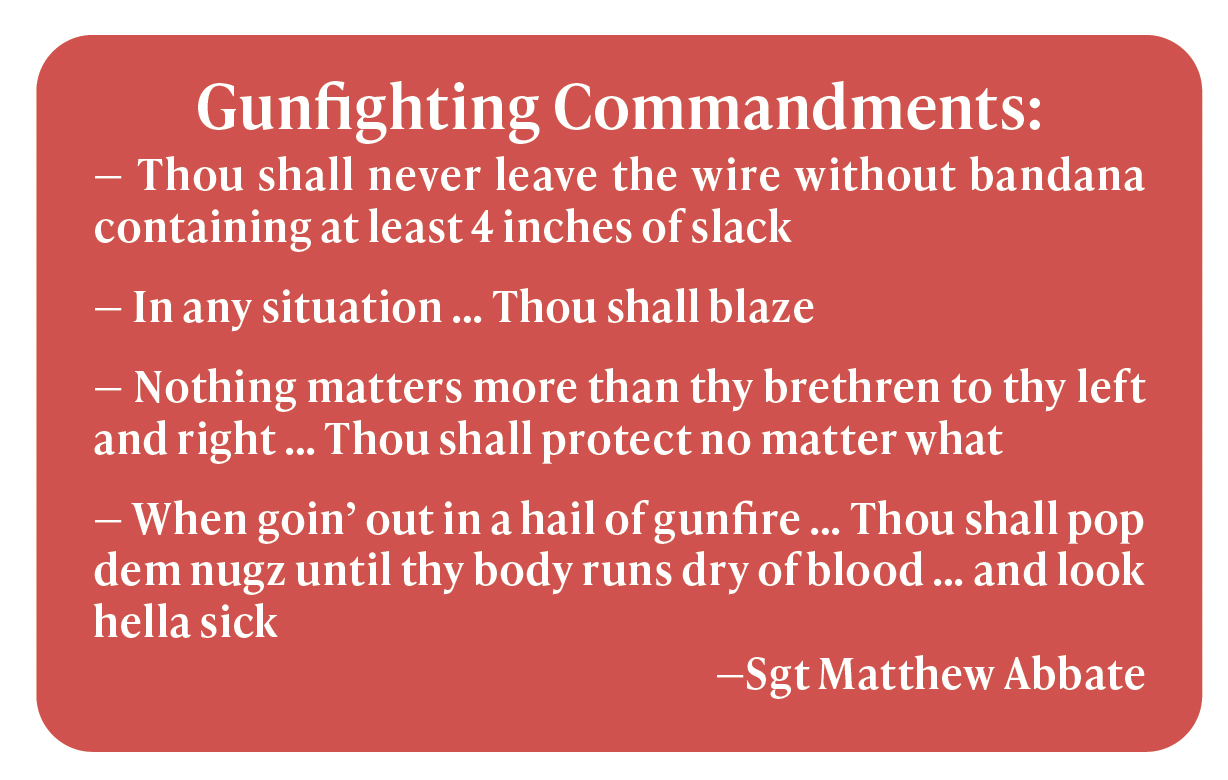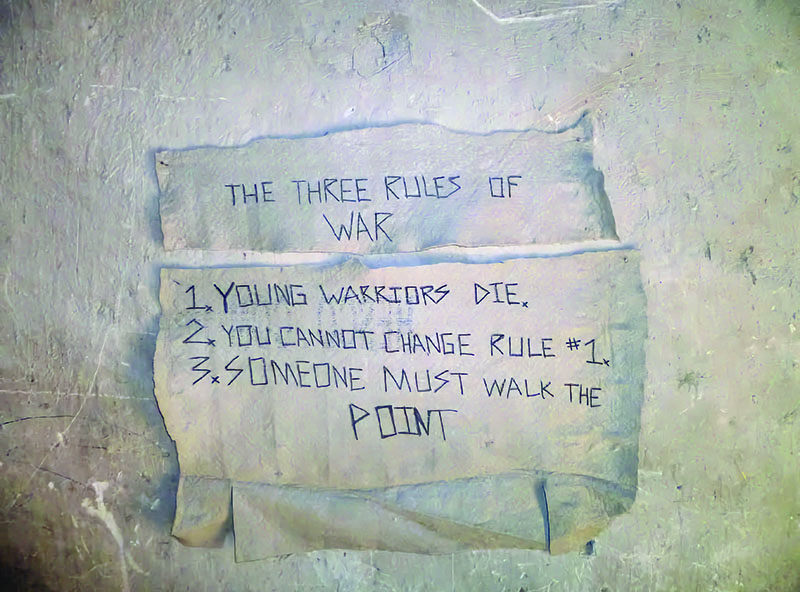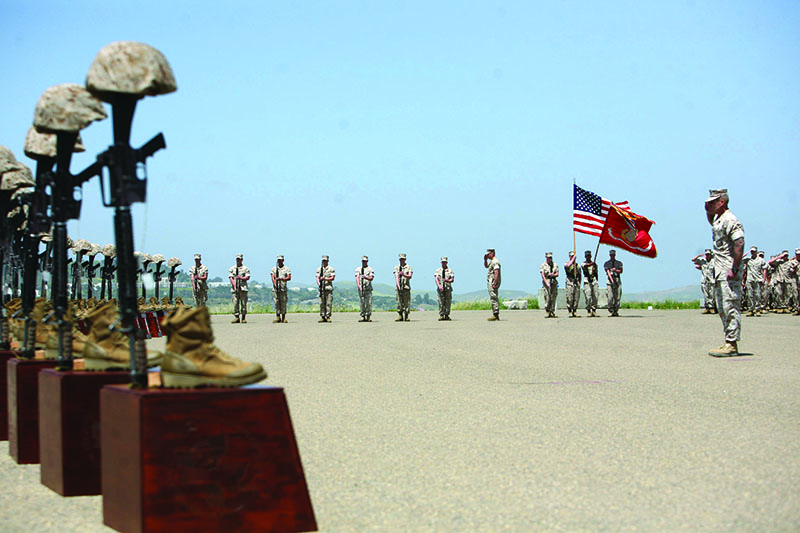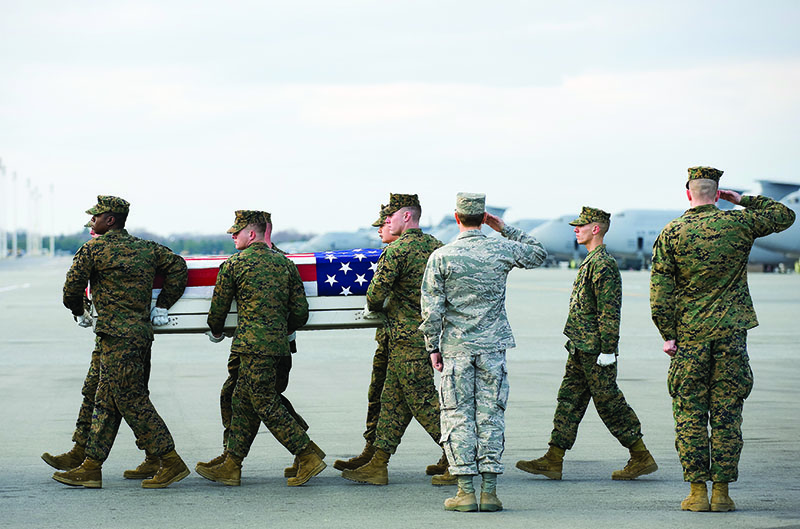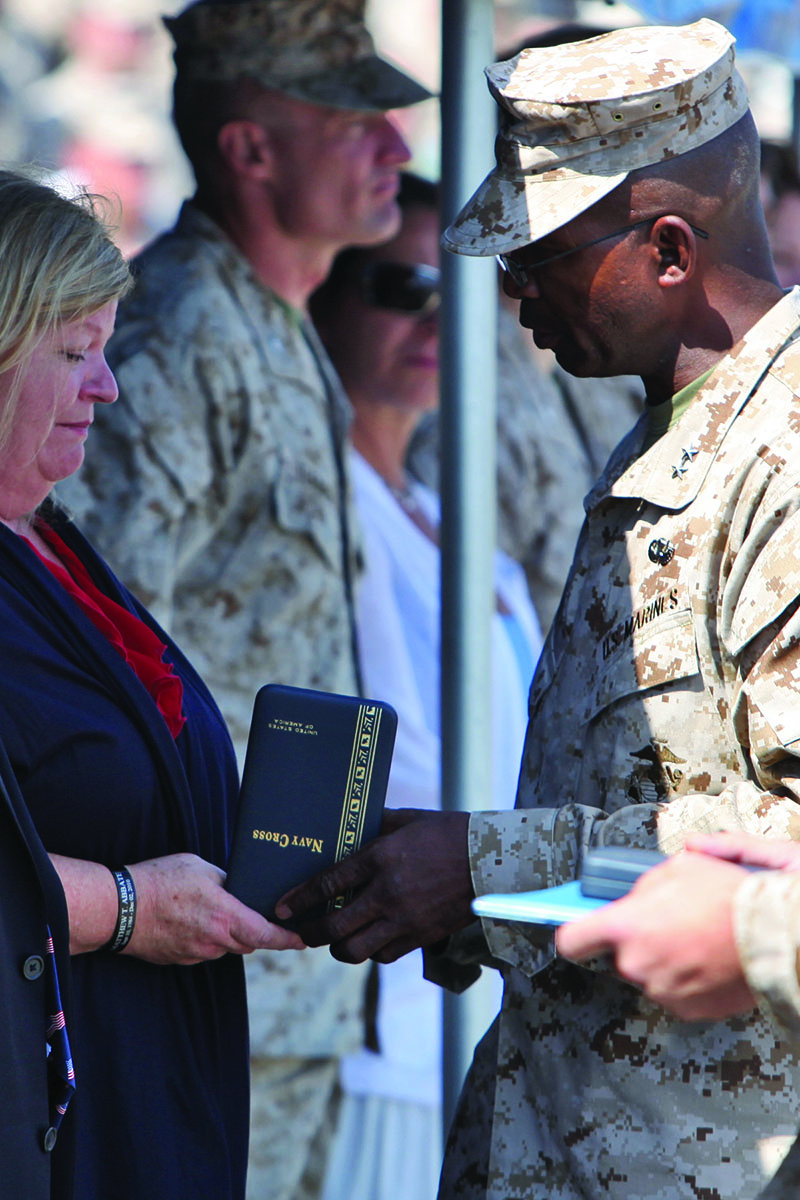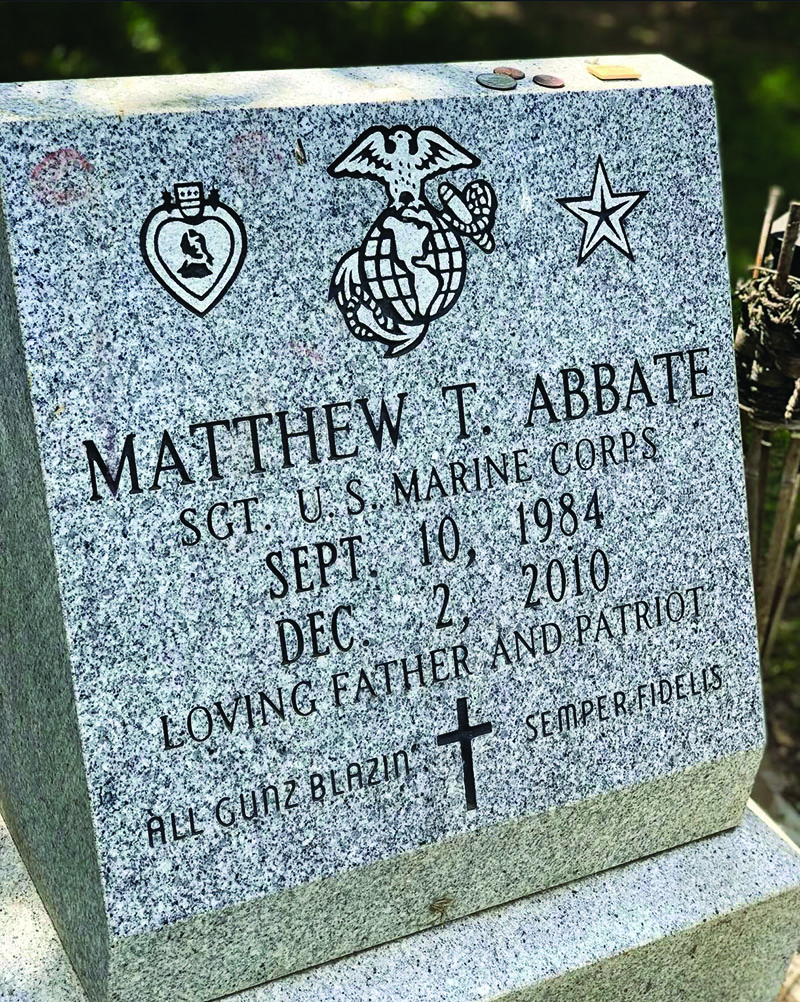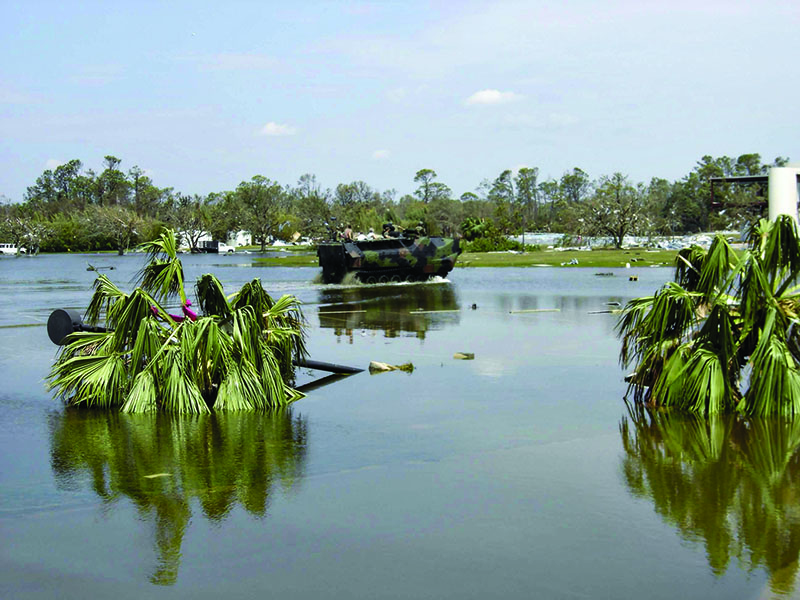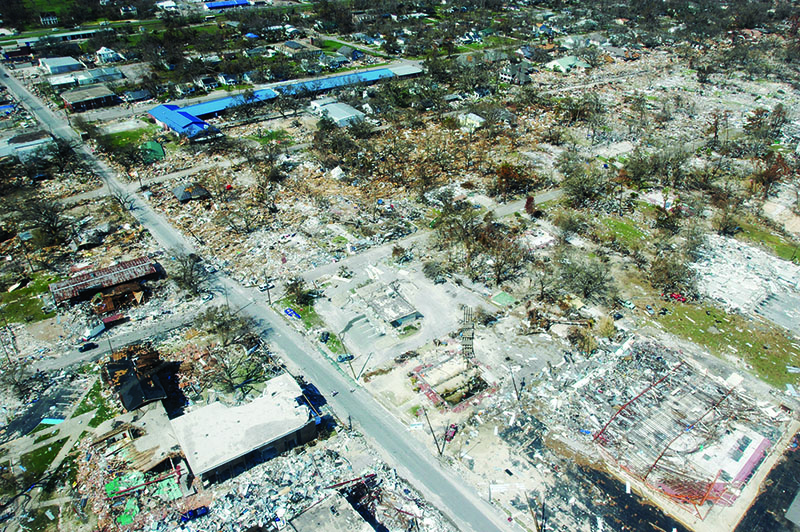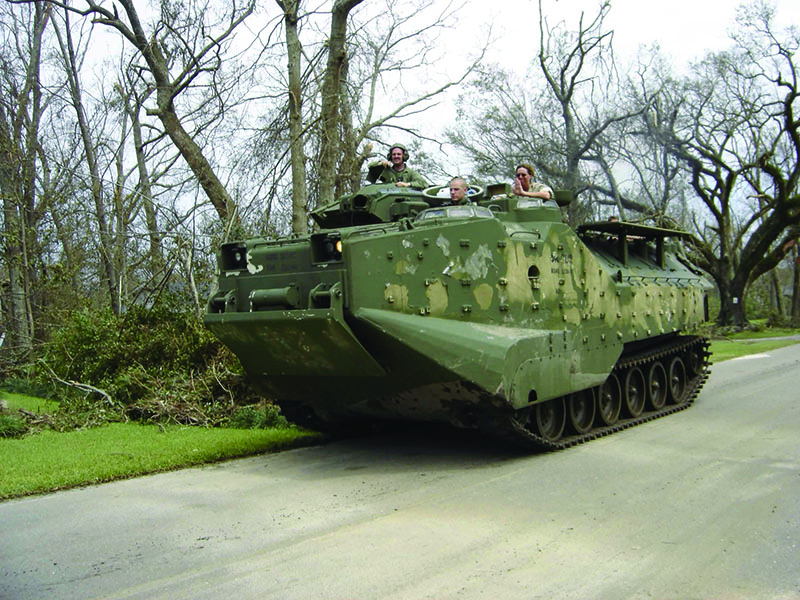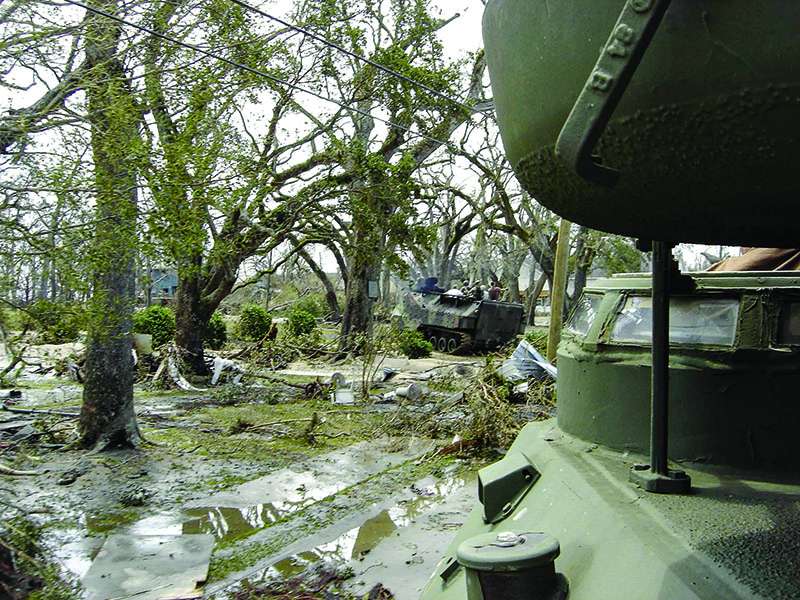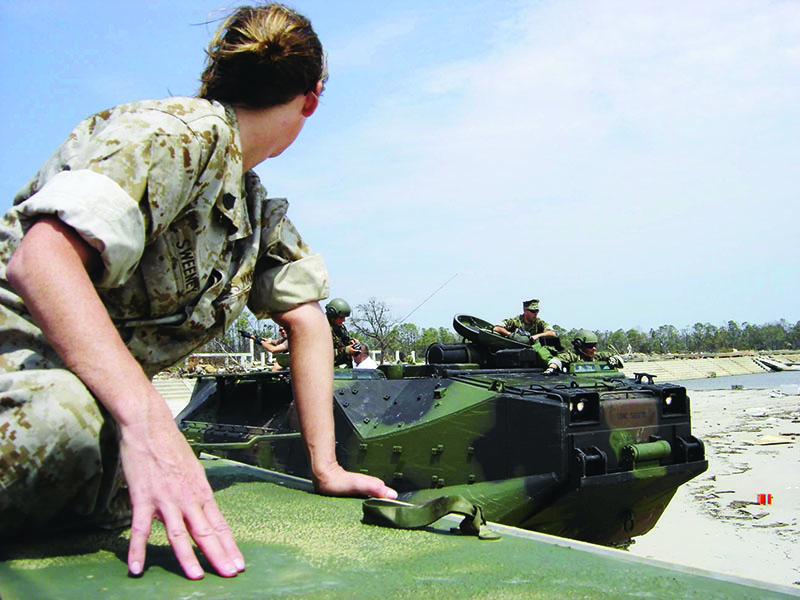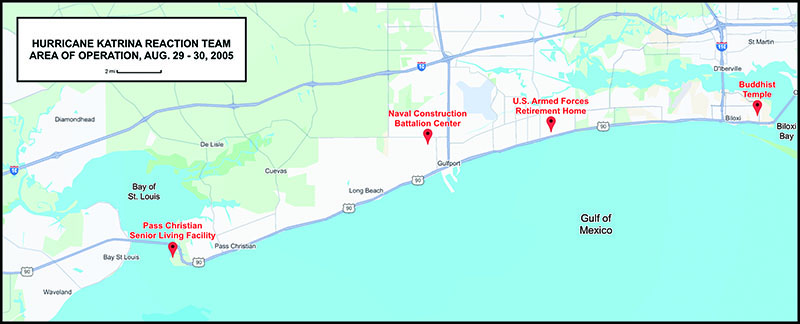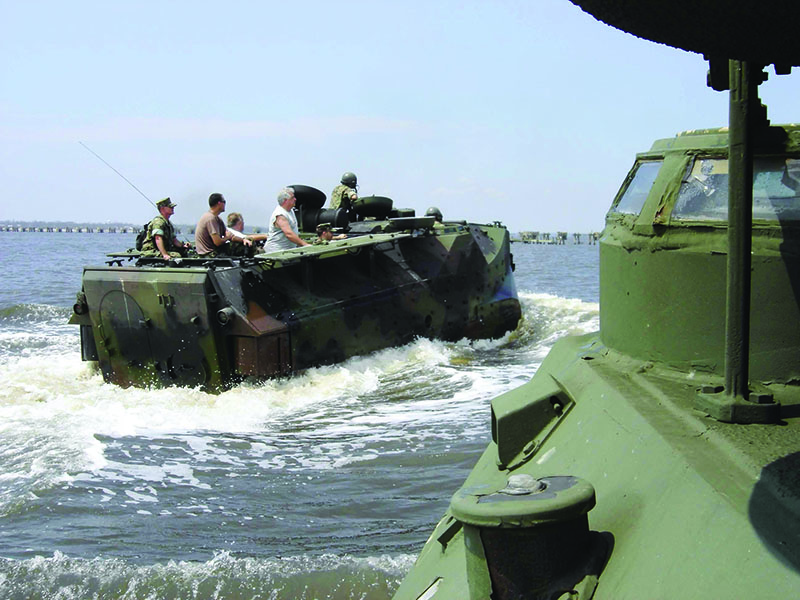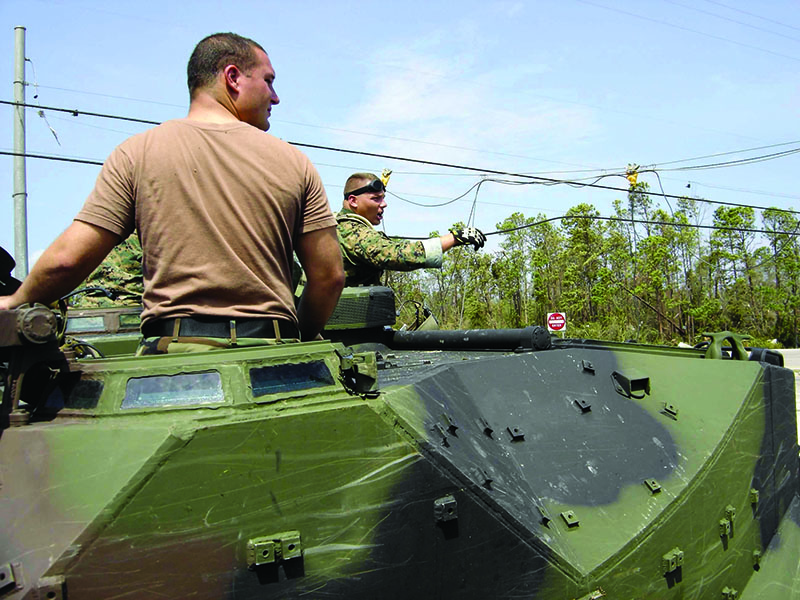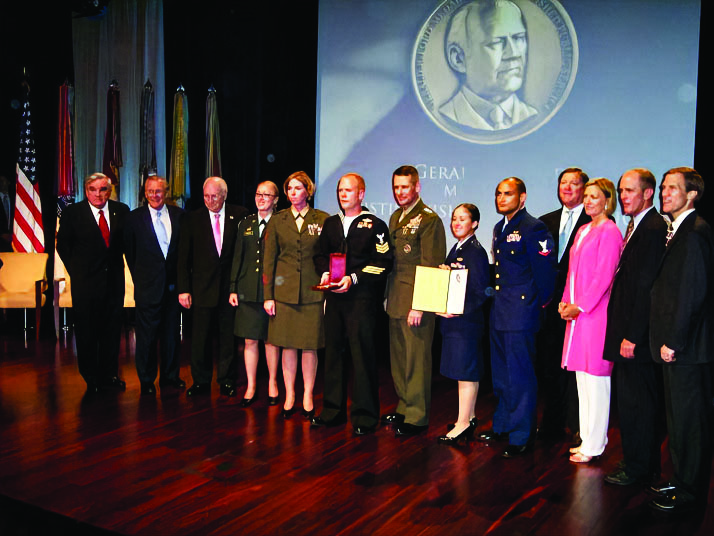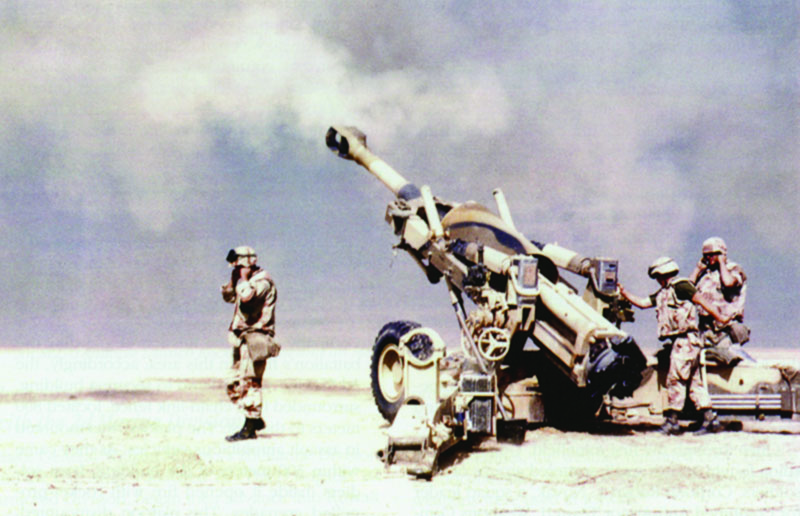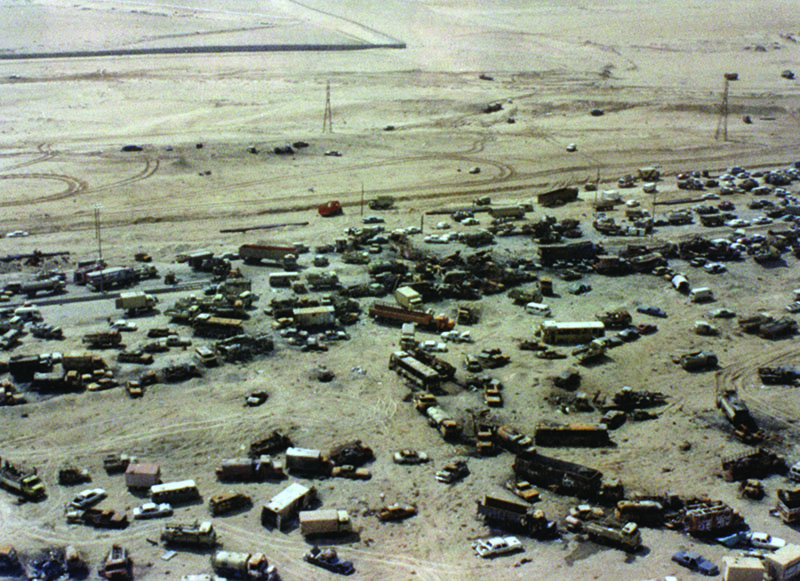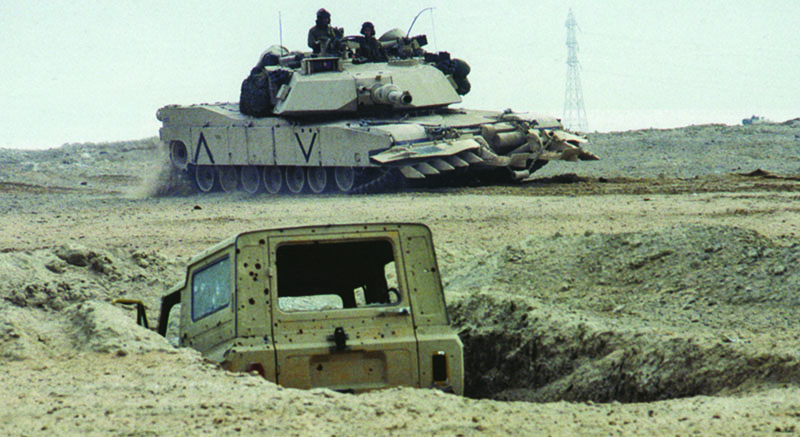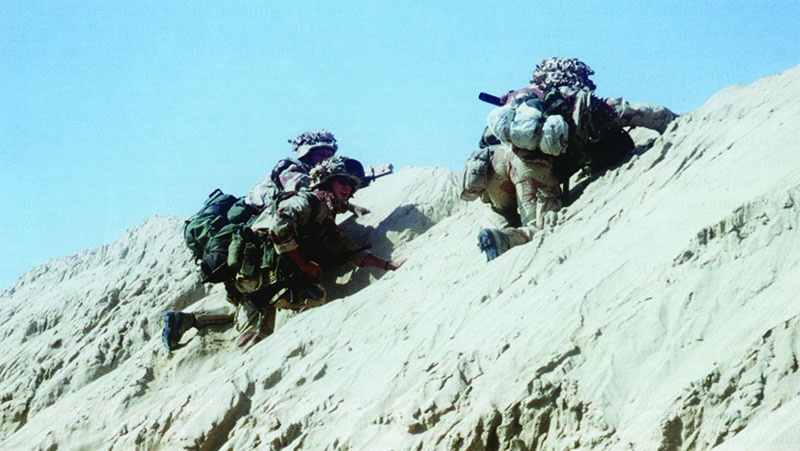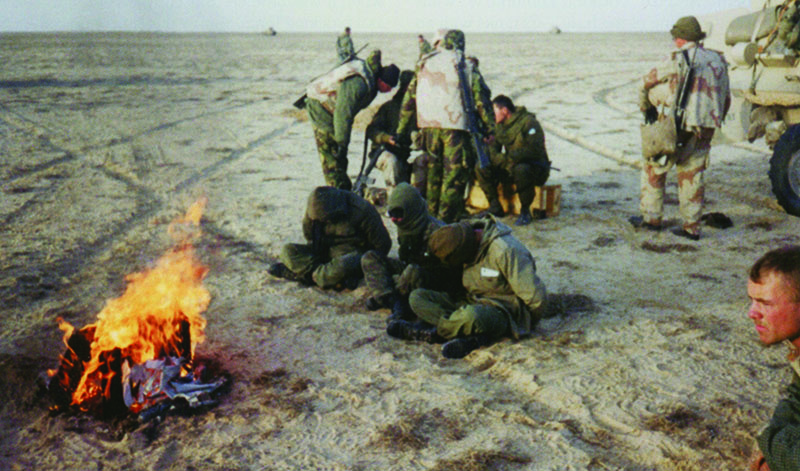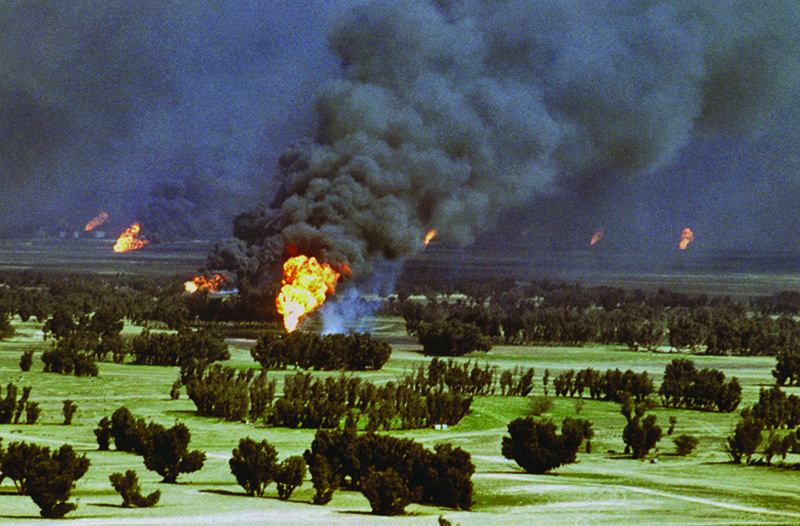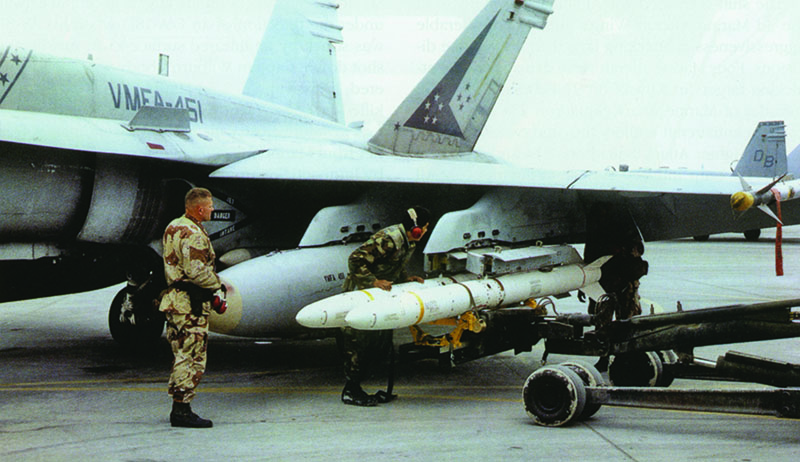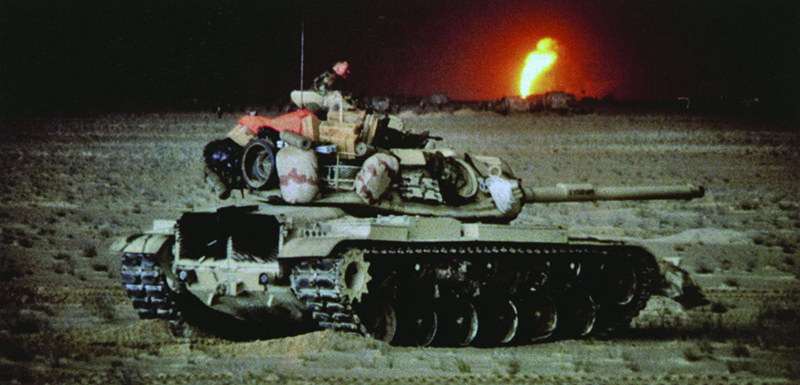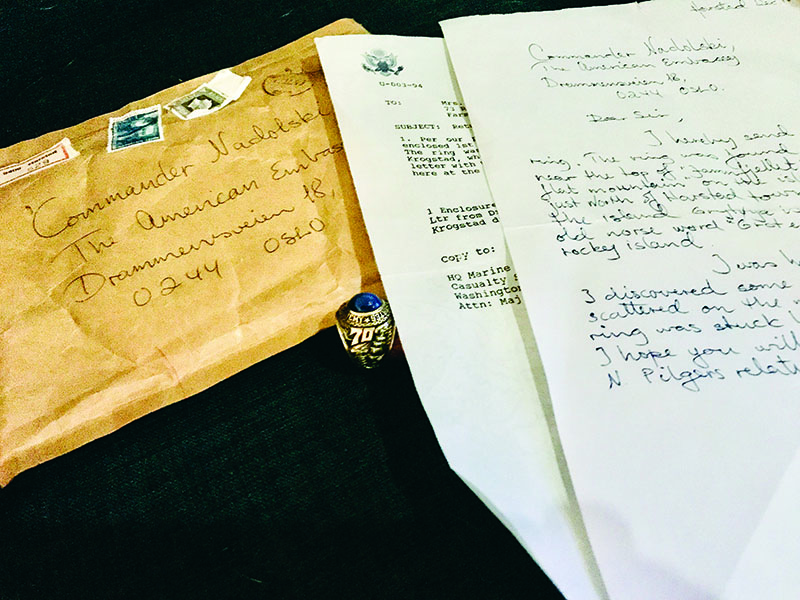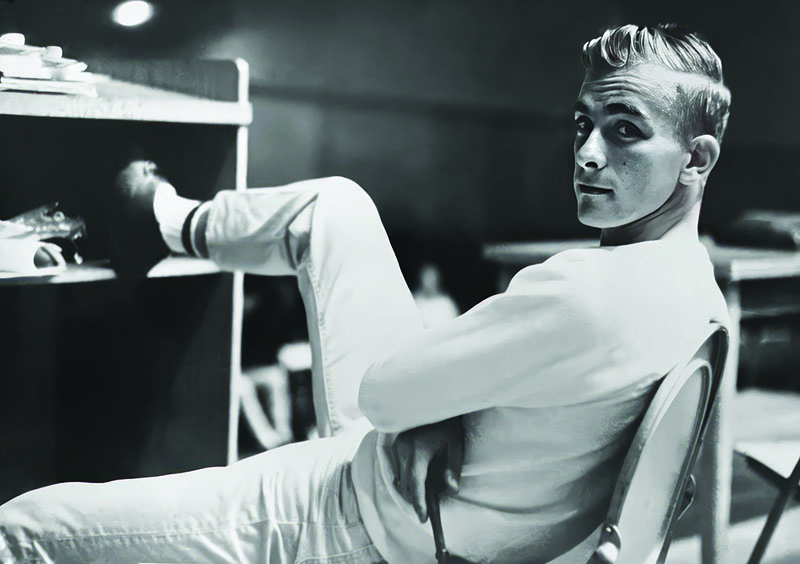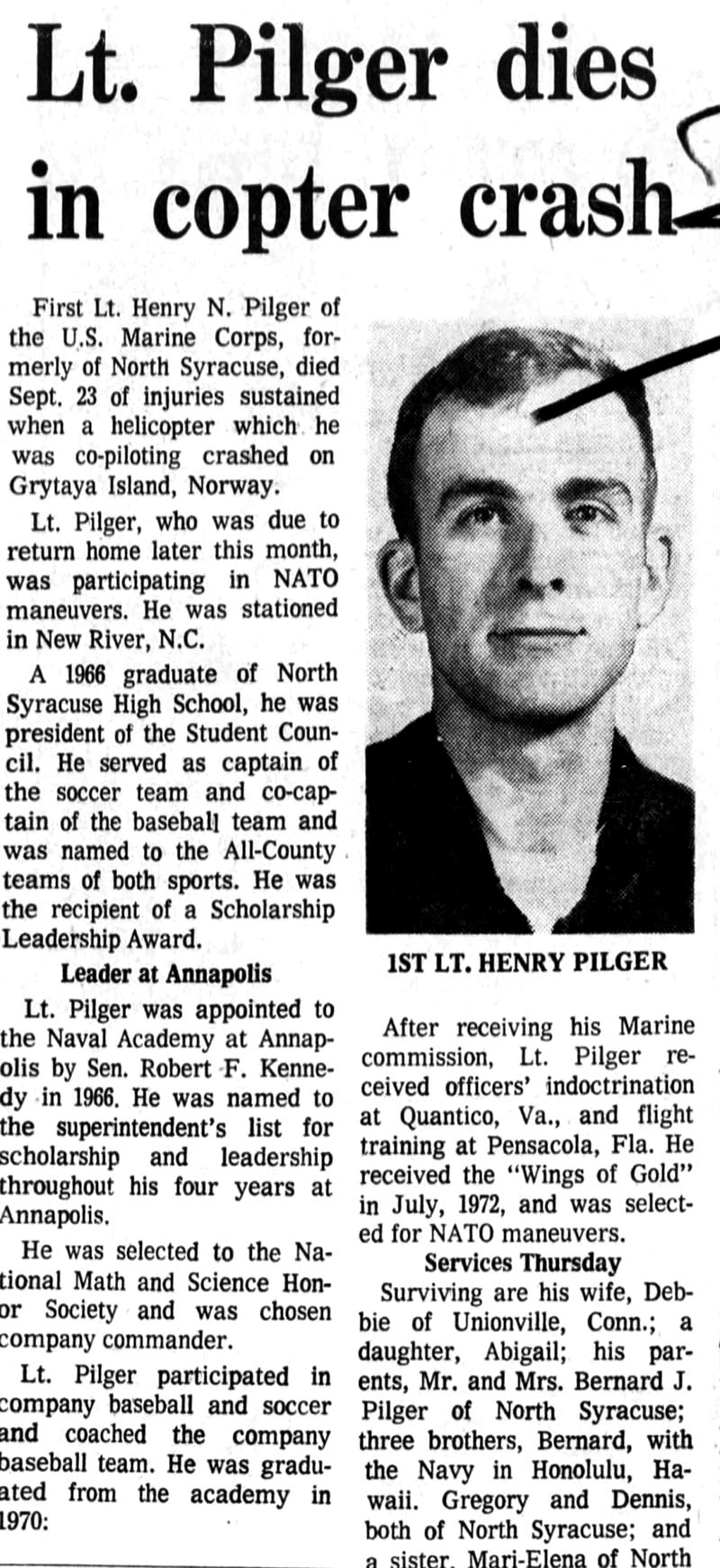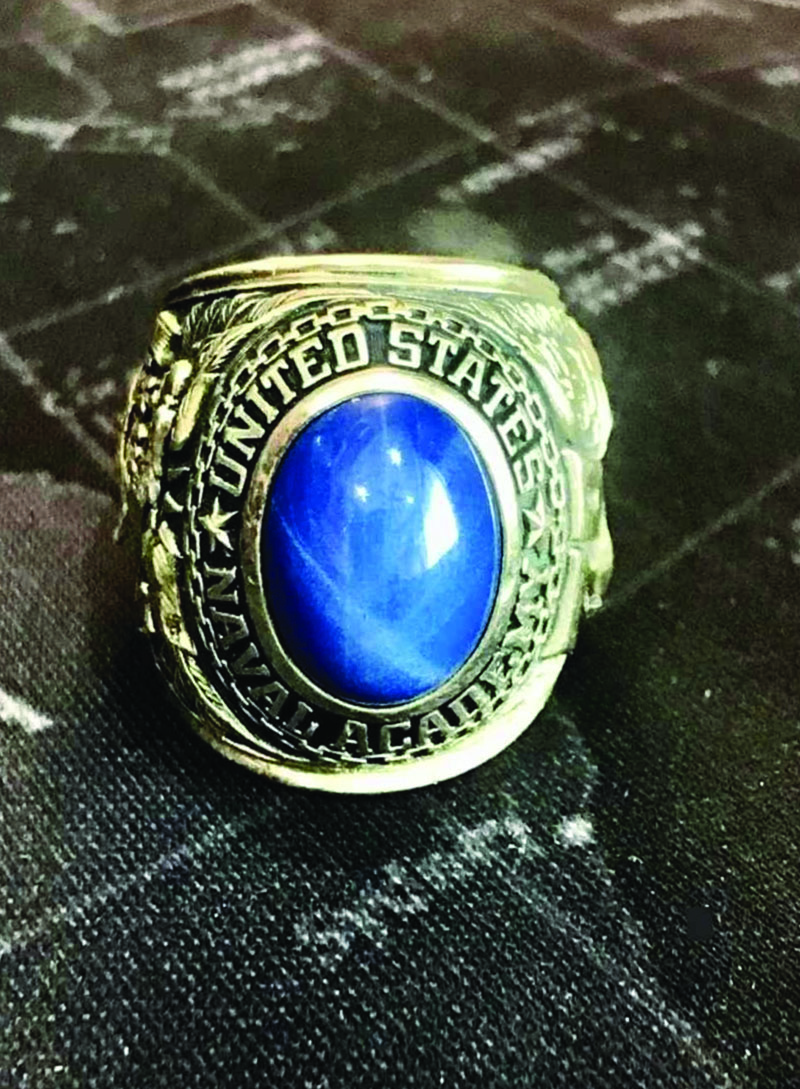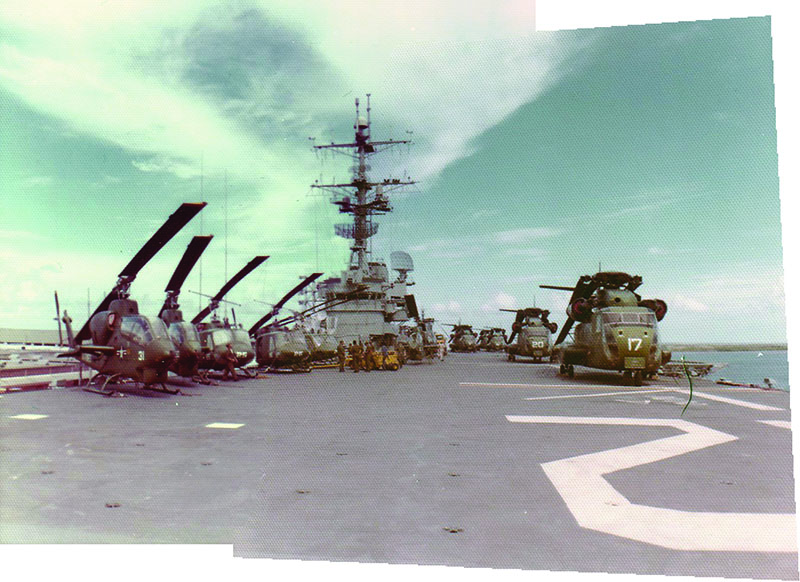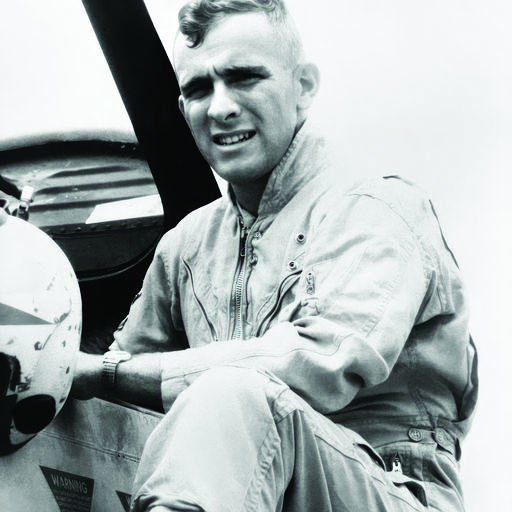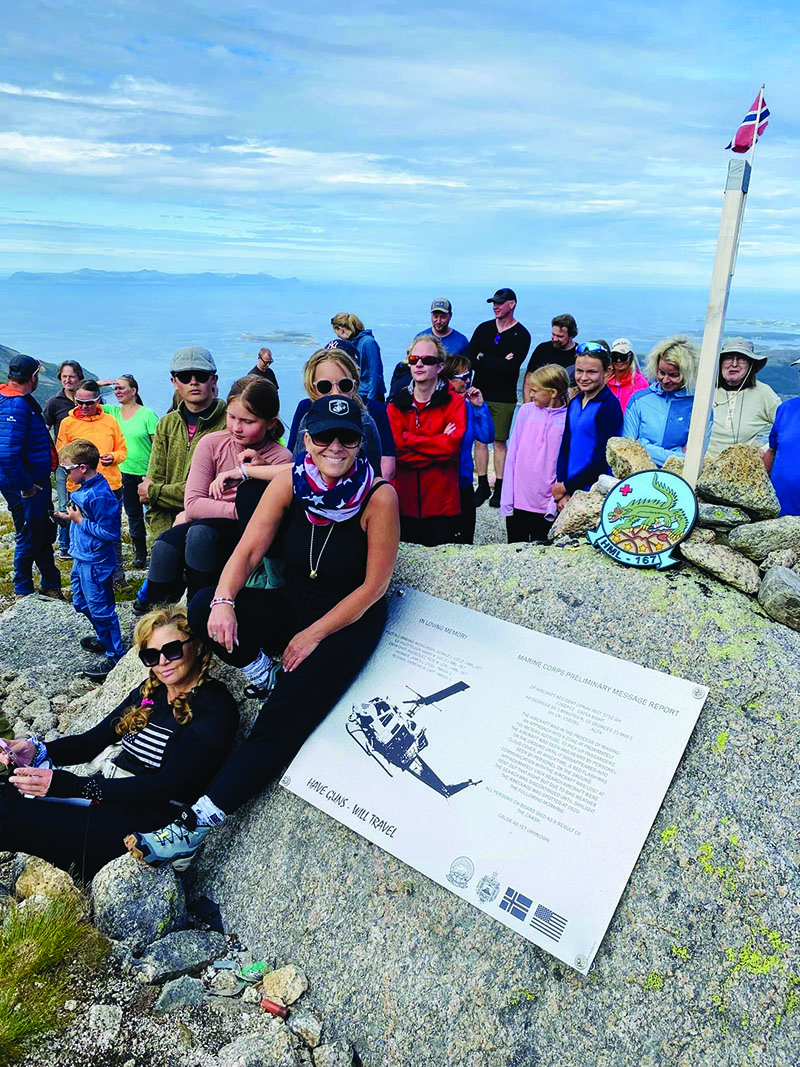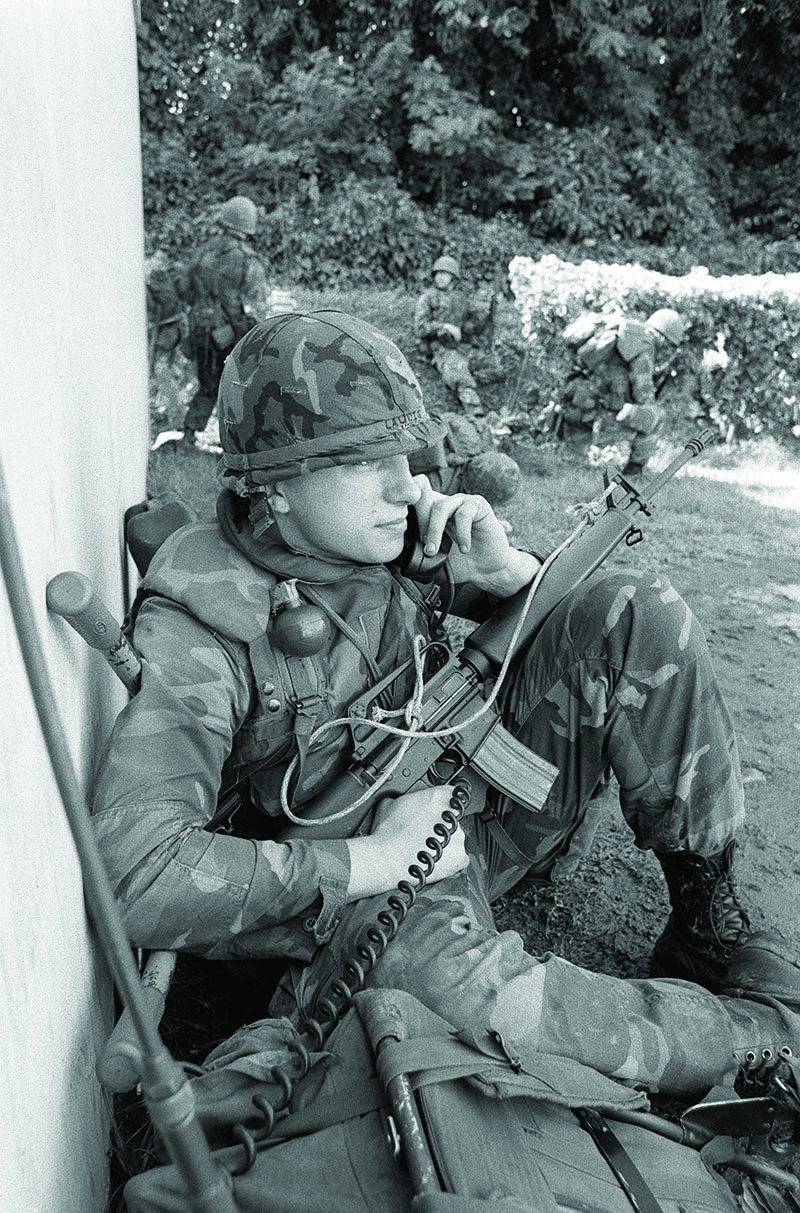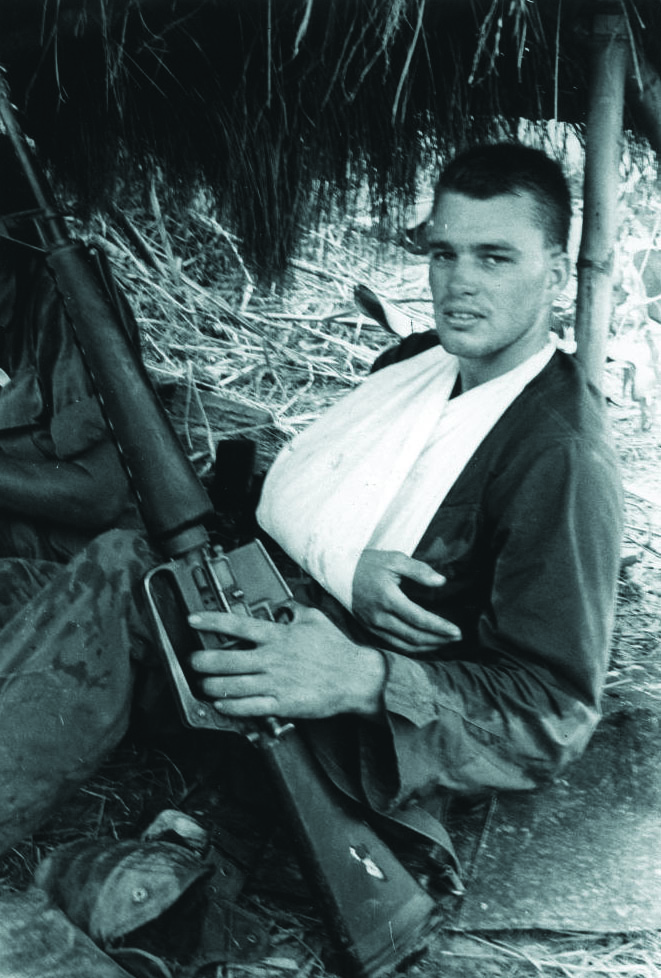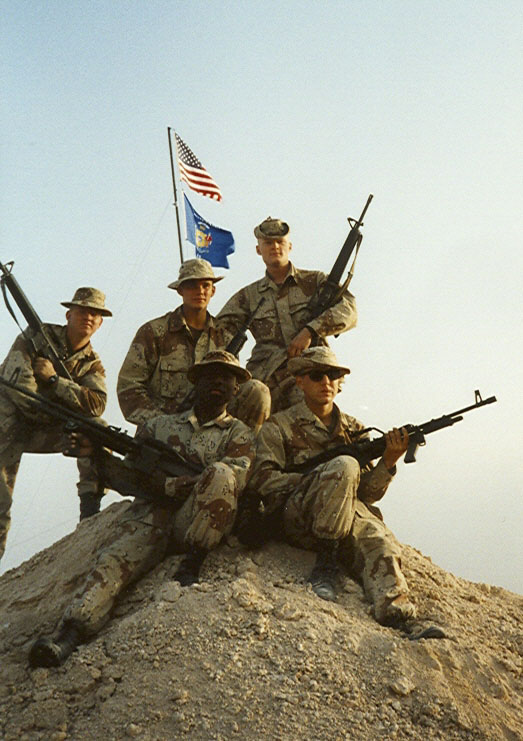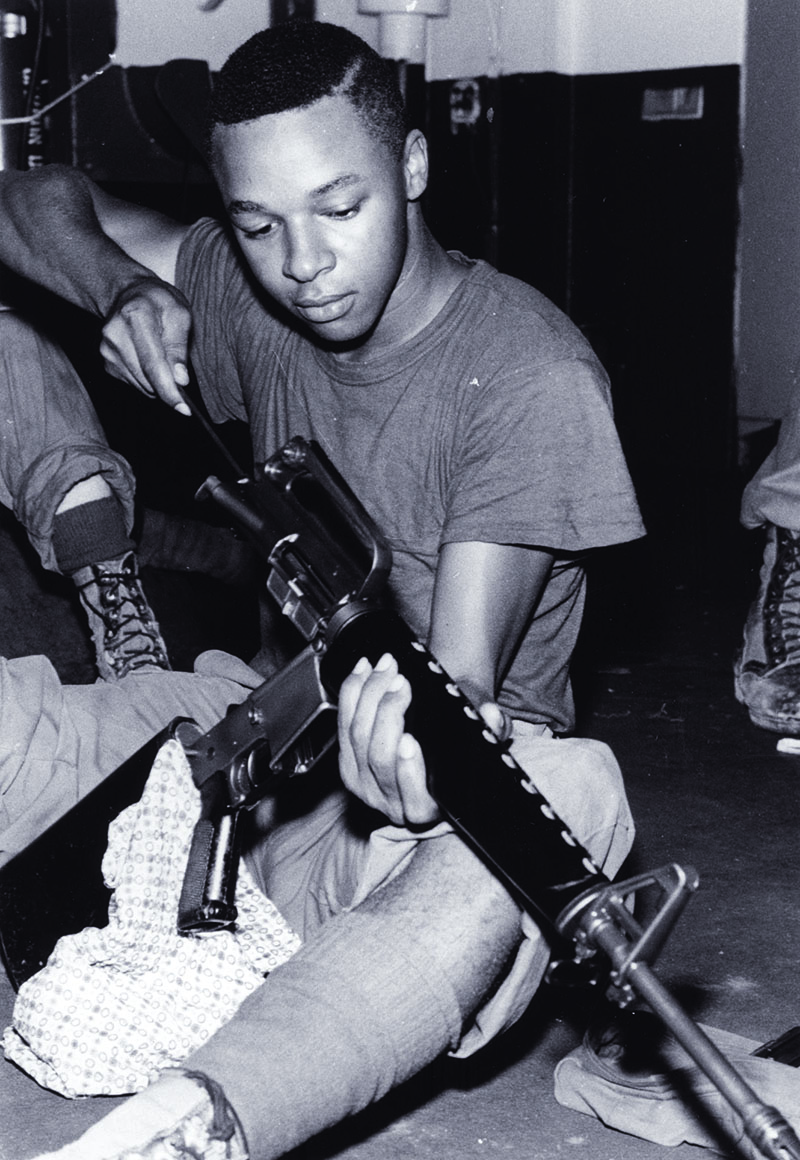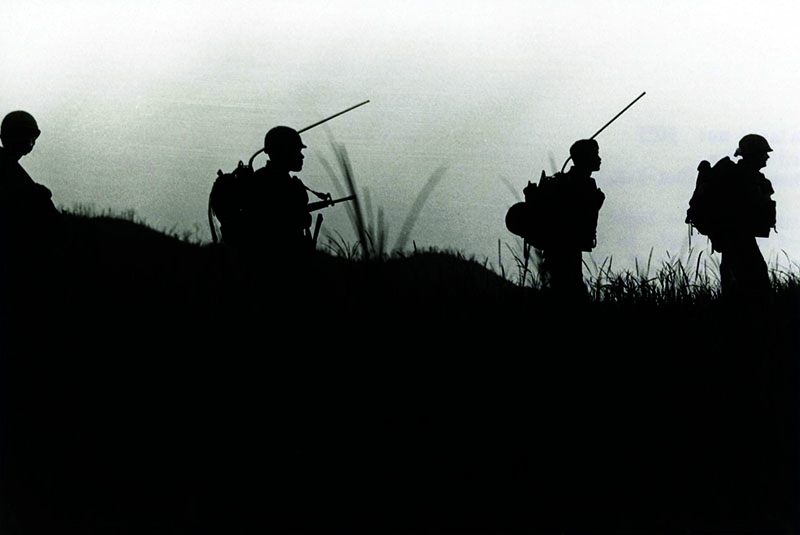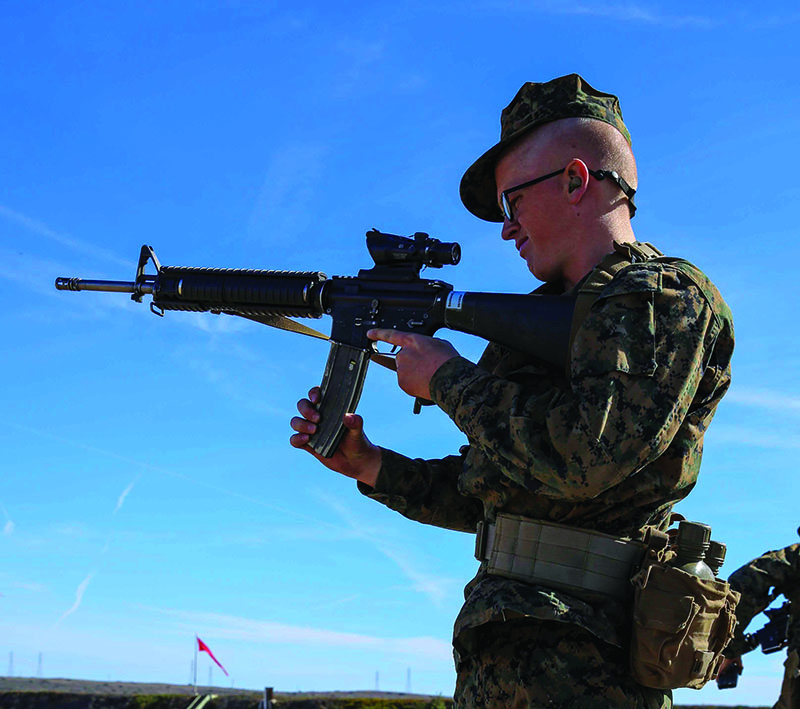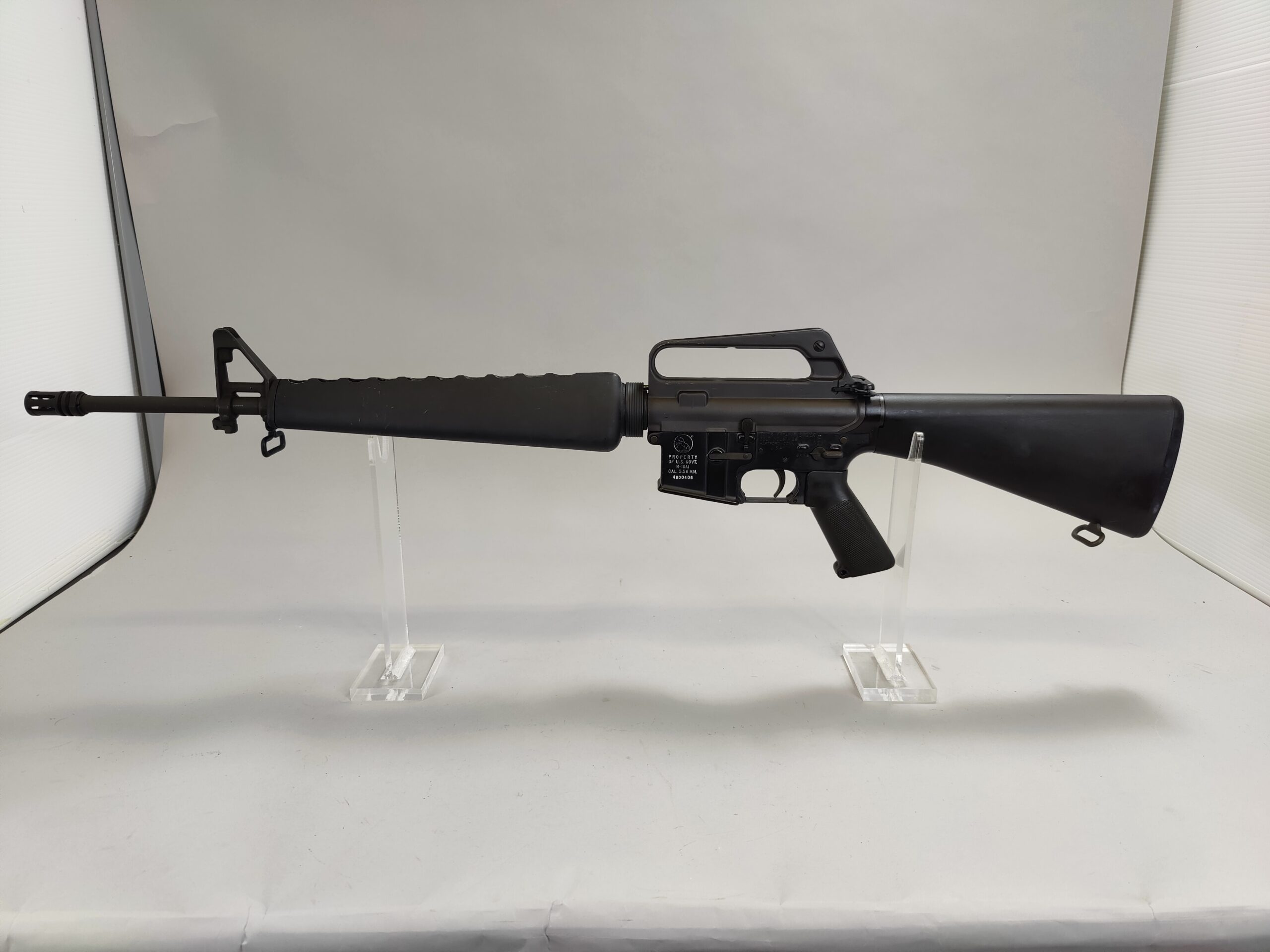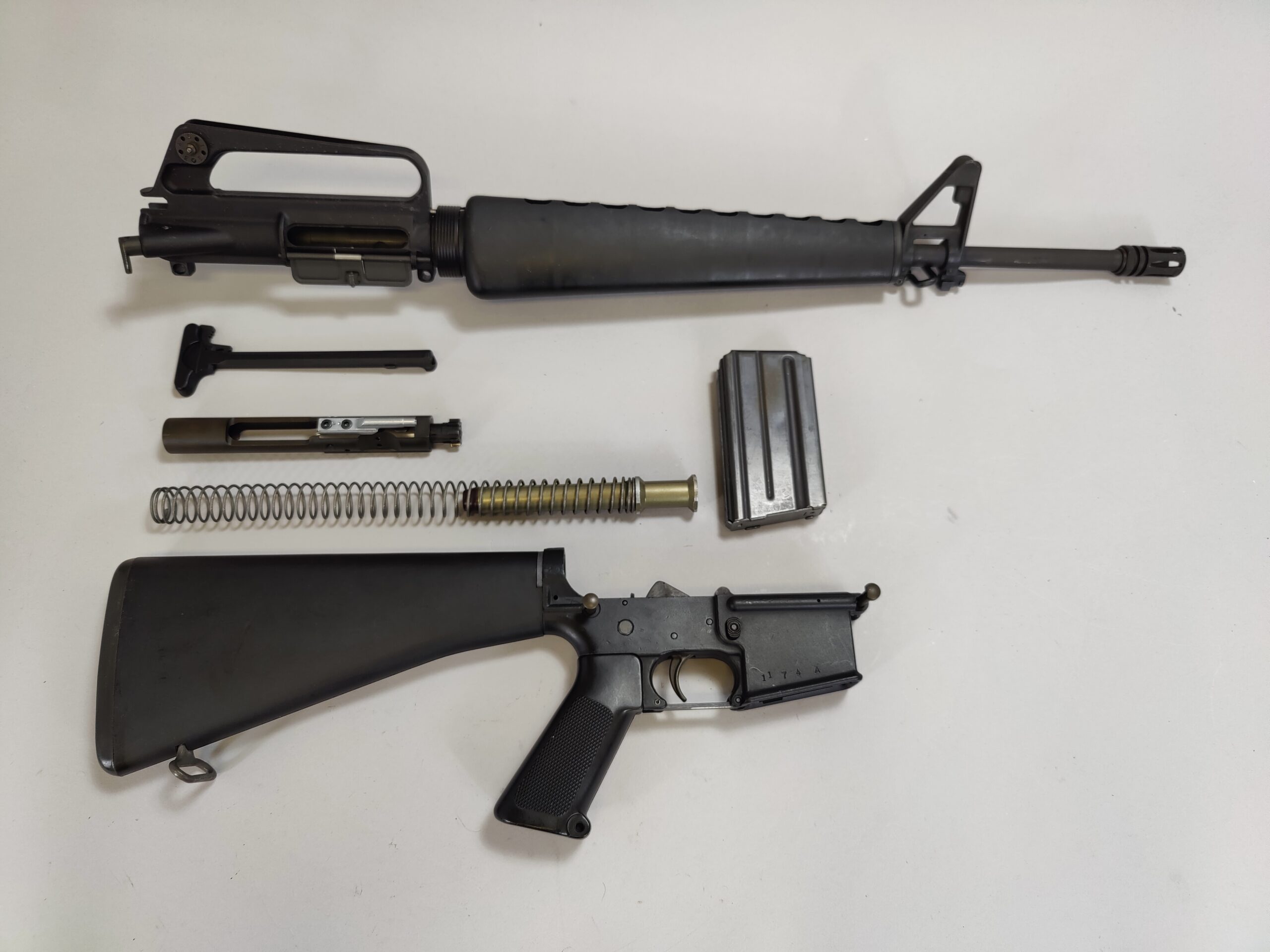In July 2005, the 13th Marine Expeditionary Unit (MEU) put to sea from California with Battalion Landing Team (BLT) 2nd Battalion, 1st Marines, embarked. The deployment began in typical fashion. Marines made port calls and participated in exercises through Australia, the Philippines and other Southeast Asian countries. By September, the MEU had sailed into the Red Sea and on to Egypt. As the Marines transited the Suez Canal, word disseminated of their next operation. The BLT was headed to combat in Iraq.
The new orders proved largely expected. Throughout the previous year, numerous MEUs supported the fighting in Fallujah, Najaf and other areas of Iraq. Even 2/1 had previously experienced an identical situation in 2003 as part of the 15th MEU, surging north from Kuwait with the initial invading force. By 2005, several invasion veterans lingered in the battalion. Considerably more had fought through the battalion’s next Iraq deployment during the First Battle of Fallujah in April 2004. Now on its third deployment in as many years, senior leaders called on the BLT to support the largest Marine Corps operation in Iraq since Operation Phantom Fury. The main effort focused on arresting control of the wildest part of Iraq’s “Wild West,” the Al Qa’im region.
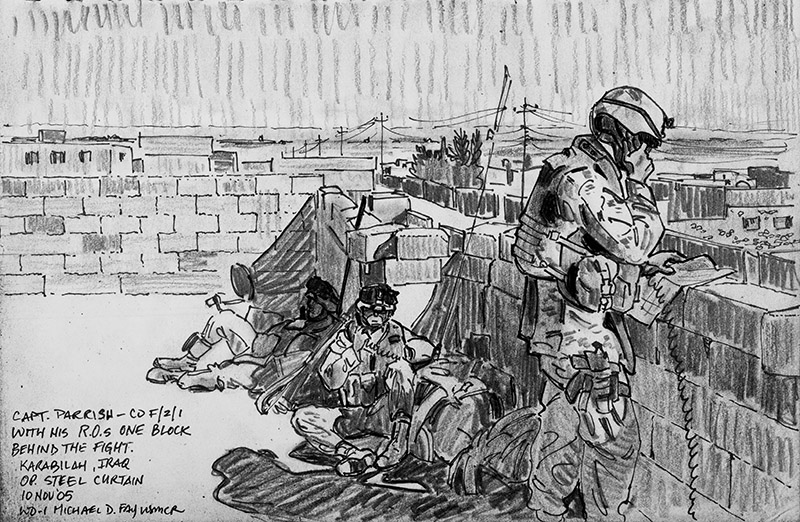
Al Qa’im made up the northwest corner of Iraq along the Syrian border. In 2004, while 2/1 battled insurgents some 200 miles down the Euphrates River valley, other Marines faced uprisings throughout Al Qa’im. On April 14, 2004, in Karabilah, Corporal Jason Dunham was mortally wounded smothering a grenade and saving the lives of two other Marines. He became the first Marine to receive the Medal of Honor since the Vietnam War. Conditions worsened as the year progressed, culminating in November when virtually all American forces departed Al Qa’im to support Operation Phantom Fury in Fallujah. The battle forced insurgent leader Abu Musab al-Zarqawi out of the city. He retreated northwest and reestablished a base of operations in Al Qa’im. Zarqawi cemented his control over the region throughout 2005, despite a persistent Marine presence and limited offensive operations. The approach of Iraqi parliamentary elections, however, demanded a secure environment in which to conduct voting. The balance of power in Al Qa’im would not truly be tested until the arrival of 3rd Battalion, 6th Marines, that August.
The Marines of 3/6 occupied Camp Al Qa’im, based several miles south of the urban centers along the Euphrates River. One company operated out of another American outpost called Camp Gannon, guarding over the Syrian border crossing in Husaybah. The Marines executed Operation Iron Fist at the beginning of October, sweeping through portions of Karabilah and Sadah and establishing forward battle positions across the region. The battalion was spread thin manning each position, most engaging the enemy in daily firefights to hold their ground.
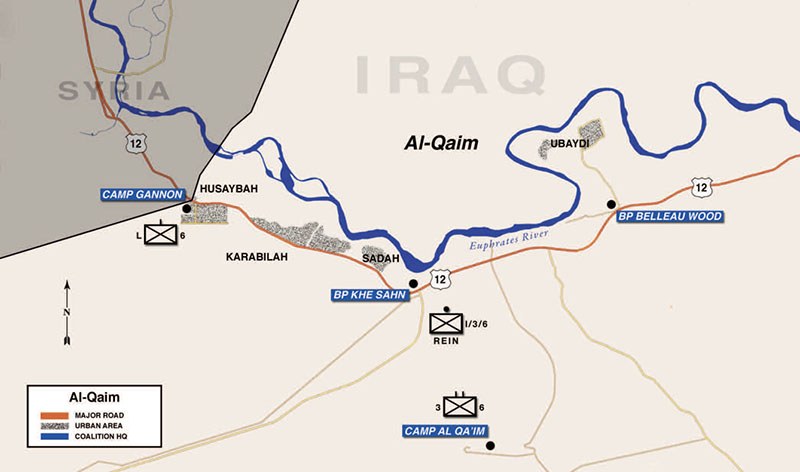
As 3/6 maintained the foothold in Al Qa’im through the remainder of the month, BLT 2/1 flew into Iraq. Both battalions would work together through the next phase of the Marines’ attack plan, dubbed Operation Steel Curtain, to clear the entire region, building by building, and drive out the insurgency before the election. The BLT transitioned rapidly from the MEU training mindset to mental preparation for imminent combat.
“Everything felt pretty surreal as I remember it,” said Justin VanHout, then a lance corporal in 2/1’s Fox Company, 2nd Platoon, 1st Squad. “Everything happened so fast. We flew from Kuwait up to Al-Asad and staged there. They sent a convoy up from Kuwait bringing all of our equipment. About that time, we got word there was some sort of accident, a vehicle rollover, and we lost our first Marine. Lance Corporal Christopher Poston. I think that moment kind of set a demeanor for a lot of us, like, ‘Well, here we go.’ Kind of gave us the impression that we were actually in it.”
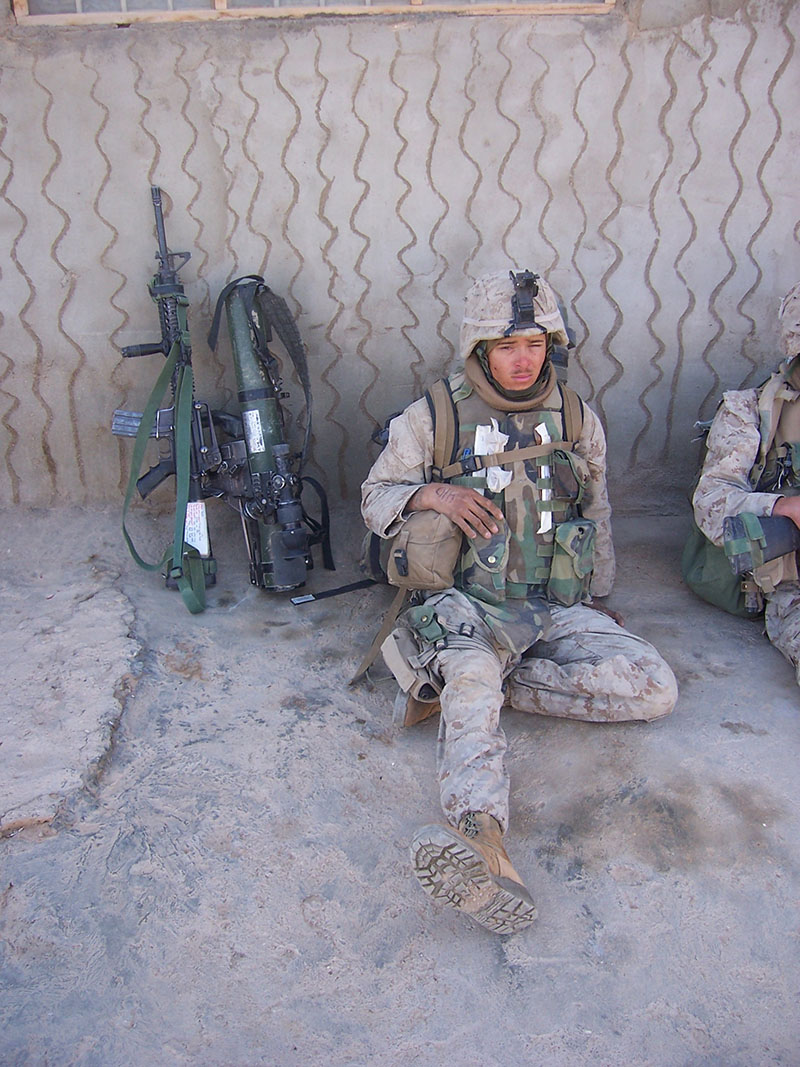
“For me, things still weren’t hitting that we were actually in a combat zone,” added Shawn Studzinski, another lance corporal in 2nd Platoon’s 1st Squad. “We’d be walking around base at Al-Asad and all of the sudden an alarm would go off because there was a mortar strike, but still it’s not clicking. Then, on one of our company’s first missions, we were barely outside the wire when one of our 7-tons hit an IED. Everybody made it out OK, but that really kind of woke me up.”
By Nov. 5, VanHout, Studzinski and the rest of 2nd Platoon had staged at the Syrian border crossing on the outskirts of Husaybah, prepared to attack east into the city. Fox Company occupied the left flank of 2/1’s advance. Their objective was to clear a modern grid-style section of the city known by Marines as “the 440 district” for the number of buildings it contained. Tense house-to-house fighting erupted across the front in spurts, increasing in frequency and ferocity as the Marines advanced. Grenades, rockets or tank main gun rounds frequently preceded grunts kicking in doors to soften up the enemy inside. The Marines worked methodically through Husaybah for three days, then moved directly on to Karabilah. After nine days of fighting, anyone left to oppose the Marines fled east down the Euphrates.
Through Steel Curtain’s opening days, 3/6 operated as the main effort. As the battalion advanced, rifle platoons re-mained behind to establish new battle positions and prevent the enemy’s return. By Nov. 13, 3/6 occupied nine separate positions sprinkled throughout Husaybah, Karabilah and Sadah. There was only one city that hadn’t been cleared. That task fell to BLT 2/1.
The city of Ubaydi lay in the center of a heart-shaped bend in the Euphrates at the eastern edge of Al Qa’im. The main road running directly up the center of the heart divided Ubaydi into “old” and “new” sections. Old Ubaydi consisted of sparsely populated farmland and anti-quated structures. New Ubaydi looked mostly like the modern urban center the BLT Marines had advanced through in Husaybah. Commanders called in supporting U.S. Army units to sweep through Old Ubaydi, while also securing any avenues of escape to the north across the river. BLT 2/1 was tasked with clearing the new city. Shooting it out in the streets morphed into point-blank combat house to house, with booby traps and hardened defensive positions greeting Marines behind each barricaded door. The insurgents’ backs were against the river, and with Americans waiting on the opposite bank, they faced the oncoming wave of Marines with no option but to hold out and fight to the death.
The grunts marched into their as-sembly areas outside Ubaydi under the cover of darkness on the night of Nov. 13. They moved dismounted into the city due to the significant threat of IEDs surrounding the area, especially along the roads. Tragically, their concerns proved well founded. As the battalion approached Ubaydi before dawn on Nov. 14, Major Ramon J. Mendoza Jr., the Echo company commander, stepped on a pressure plate. The resulting explosion killed Mendoza and wounded other Marines in the vicinity.
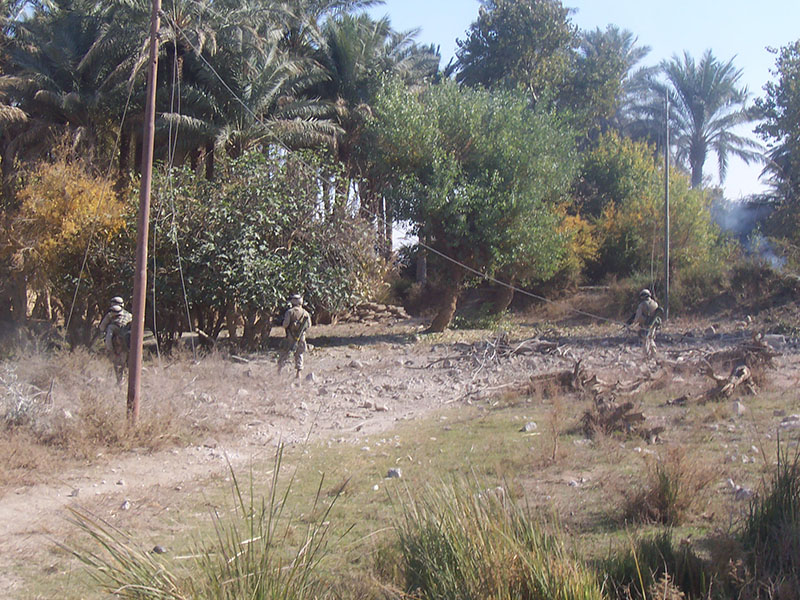
The BLT assaulted north shortly after sunrise. A new level of intensity hindered their progress. From Fox Company’s 1st Platoon, LCpl Christopher M. McCrackin burst into one house, triggering a hidden explosive device. Shrapnel tore into his body, leaving him mortally wounded. Several hours later, Cpl John M. Longoria breached a door with his fire team and ran into five insurgents armed with machine guns. In the ensuing firefight, Longoria was shot in the neck and killed.
“There was one point where our [standard operating procedure] was to put a grenade, M203 round or SMAW rocket into every building before Marines went in because you just didn’t know what you were going to meet on the other side of the door,” said Jeff Jendrzejczyk, an 0351 assaultman and SMAW gunner attached to Fox Company, 2nd Platoon, 2nd Squad. “I fired 113 SMAW rockets in combat. Most of those were in Ubaydi.”
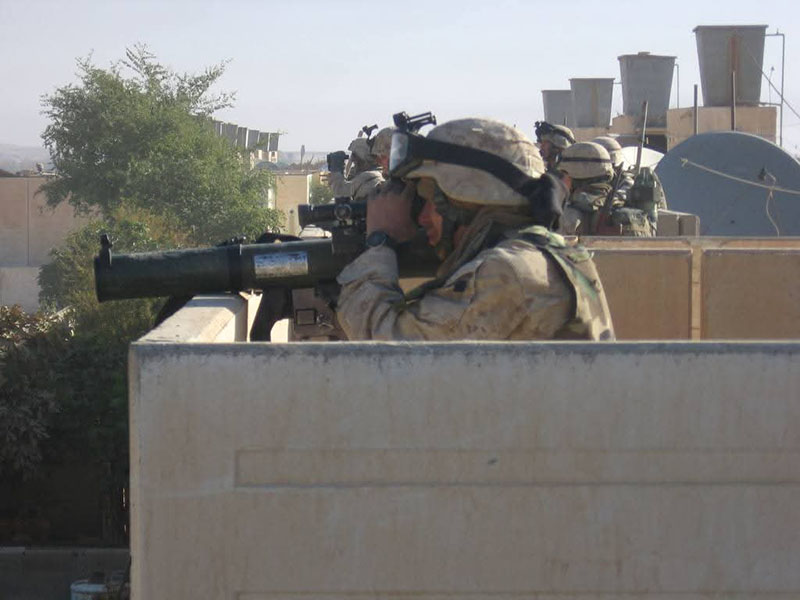
For two days, Fox Co pushed through the city, emerging from the urban maze into a sprawling countryside of farmland leading up to the Euphrates. On the morning of Nov. 16, the company spread out on line to sweep across the remaining ground. 2nd Platoon fell in the company’s center. A complex of 20 farmhouses and other structures stretched across several hundred meters along the Marines’ path—the last buildings between them and the river. A large grove of palm trees stood beyond the houses, obscuring the Marines’ view of the riverbank.
Three rifle squads filled out 2nd Platoon. 1st Squad cleared through structures around the outer rim of the complex, while 3rd Squad moved up the center. 2nd Squad remained behind, providing ground security for the BLT’s tank platoon.
“1st Squad was moving along this long stone wall towards a building on the edge of a collection of farmhouses,” VanHout said. “We stopped for a minute and all of the sudden there was a big boom. Something went off on the other side of the wall. Next thing we knew, there was gunfire everywhere and everything is going to hell. We sprinted to the end of the wall and got into our assigned building. Just as we finished clearing the first floor and another team was moving up the stairs, an insurgent burst into the house through an open back door. He had no idea we were in there. Shawn Studzinski and several others were still in the hallway when the insurgent started firing. Sparks were flying everywhere and one of our engineers got shot through the wrist. I was just inside a room next to them. I remember watching Shawn like in slow motion. He turns, drops to a knee, perfect freaking Marine form, and ‘Boom! Boom!’ Double-taps the guy right in the chest.”
“The insurgent fell into a room down the hall … and we could see his feet sticking out into the hallway,” said Studzinski. “We could see he was still moving. The engineer who was shot started screaming behind me. One of the team leaders yelled at us to frag the room. I kept watch on the doorway while VanHout moved up and pitched a grenade into the room. Somehow, the guy was still alive after it went off, so we captured him and turned him over to the Iraqi forces with us.”
“I made it up to the roof and someone told me to start firing 203 rounds into the palm grove beyond the houses,” VanHout said. “I looked down into the courtyard outside the house and saw a blown-up car and dead cow blown to pieces. I was trying to connect all the dots; the explosion, the gunfire, the insurgent we killed. In that moment, we were all so isolated inside that house. We had no knowledge of what was going on with the rest of the platoon. In hindsight, I think that initial explosion was the kicker that started everything that morning. But at the time, we had no idea that 3rd Squad and some of the other guys were in total mayhem.”
As the shooting began, 3rd Squad moved toward the buildings near the center of the complex. The squad oper-ated short-handed with only two fire teams. One team set up in a building to provide overwatch while the remaining team prepared to make entry into a farmhouse 75 yards away.
Nineteen-year-old LCpl Ben Sanbeck stacked up with his fire team outside the front door. Sanbeck took point with Cpl Joshua J. Ware next in line and two more Marines behind him. Ware pushed his hand against Sanbeck’s shoulder, silently signaling the junior Marine to dart right once they made it through the door. Over the preceding days, every Marine in 3rd Squad had expended their fragmentation grenades clearing house to house. The only thing Sanbeck possessed was a flashbang.
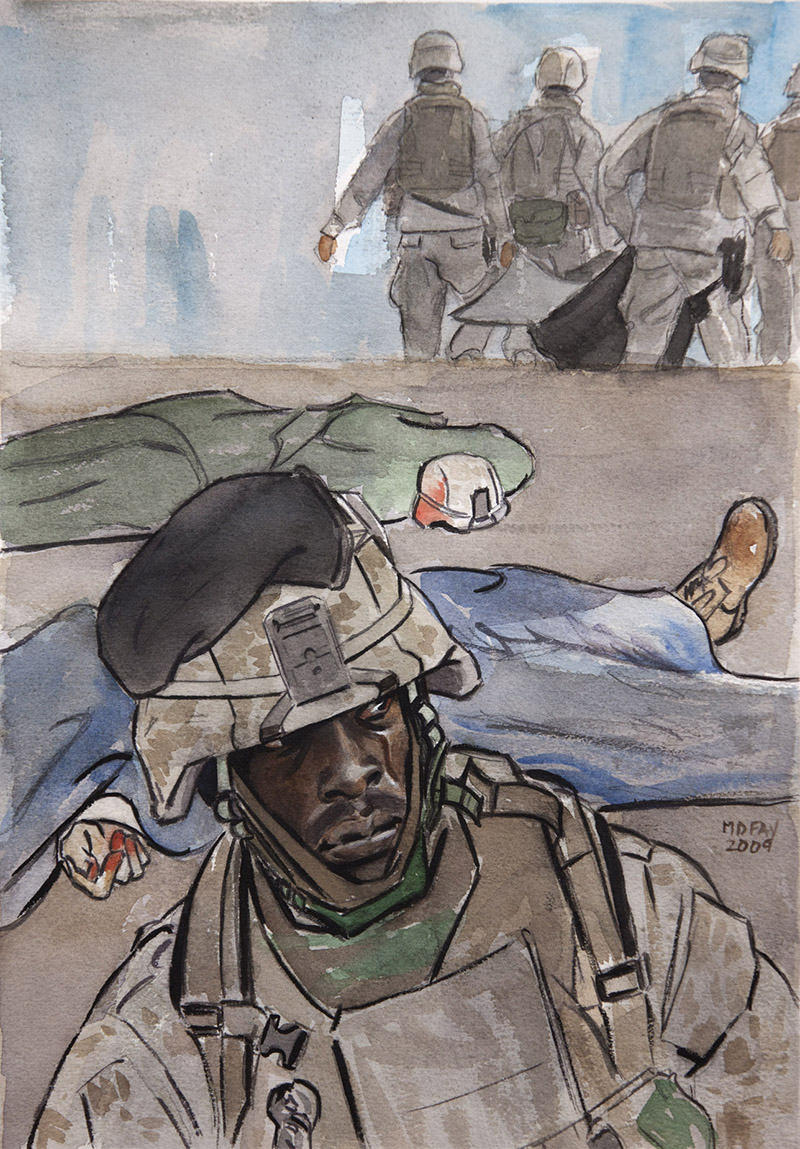
“I threw the flashbang through the door and all that did was stir the hornet’s nest,” Sanbeck reflected today. “That gave them timing. They knew as soon as it went off, we were coming through the door. I rounded the corner and as soon as I made entry, the insurgents already had a grenade in the air. It landed between me and Ware and went off before I could even yell ‘Grenade.’ Then an RPK machine gun opened up and chaos ensued.”
The Marines unknowingly made entry into a barricaded insurgent stronghold: the enemy’s last stand. Numerous enemy fighters lay behind toppled wardrobes or other objects providing cover. Others carved small mouse holes through walls at waist level, directing their fire just below the Marines’ body armor. More of the enemy waited outside in other structures or concealed within the palm grove, waiting to engage additional Marines coming to rescue those who ended up inside.
Sanbeck’s momentum carried him through the doorway and into a room off the main hallway just inside. Three machine-gun bullets grazed off his helmet as he fell. The grenade blast decimated both his legs and blew his M16 out of his hands. The grenade mortally wounded Ware, who slumped in the hallway. A machine-gun bullet struck the next Marine in line in the center of his helmet, ricocheting off the night vision goggle mount and knocking him back through the door. The last Marine in the stack also fell back outside the front door with shrapnel wounds from the grenade blast.
“I was so beat up from that grenade, I’m pretty sure the enemy thought I was dead,” Sanbeck said. “There was so much blood coming out of my legs, I’m pretty sure at some point I probably lost consciousness. I was stuck inside that room, knowing the rest of my team was pinned down outside, trying to figure out where they were, but they couldn’t hear me over all the gunfire.”
From their overwatch position 75 yards away, the remainder of 3rd Squad watched in horror as their fellow fire team shattered. They were close enough to see and hear what was going on, but too far away to communicate. Each team possessed personal short-range radios. Amidst the gunfire and explosions, no one from the team inside the stronghold was answering. Cpl Jeffry A. Rogers, LCpl John A. Lucente, LCpl Joshua Mooi and a combat engineer attached to the squad immediately sprinted toward the house.
Insurgents opened fire as the Marines dashed over the open distance. One bullet tore through the engineer’s leg. Rogers helped him move to cover while Mooi and Lucente reached the house and staged outside the front door. The last two Marines from Sanbeck’s fire team lay bleeding and dazed just inside. Mooi and Lucente snatched them both and moved them 25 yards under fire to another structure nearby.
“That building became our casualty collection point simply because we brought the wounded there and that was the best we could do,” remembered Mooi today. “This very quickly went from a casualty incident to a mass casualty incident.”
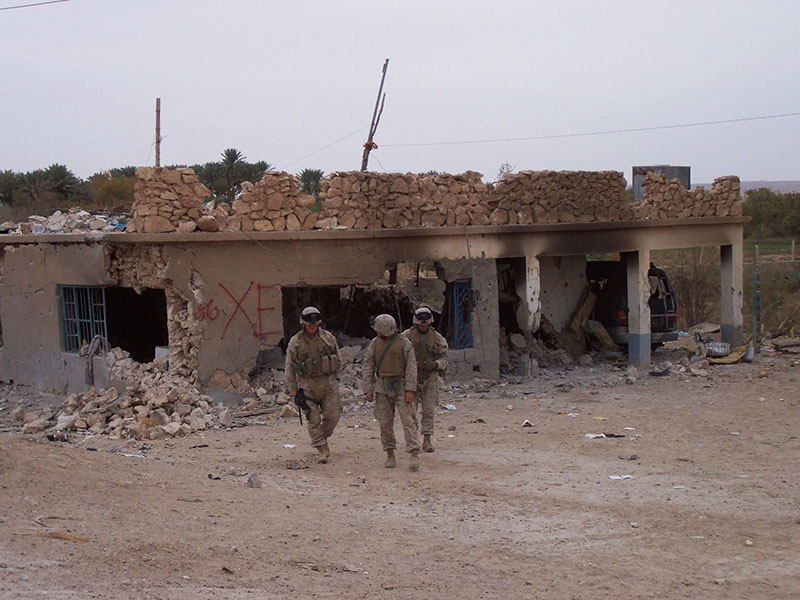
Staff Sergeant Robert Homer pushed up to the front door as Rogers, Lucente and Mooi returned to search for Sanbeck and Ware. As 2nd Platoon’s platoon sergeant, Homer immediately communicated the situation over the radio and ordered 1st and 2nd squads to collapse on the house. Standing at the front door, Mooi shouted through the opening trying to locate Sanbeck, who struggled to respond over the roar of gunfire. Finally, the Marines lay down enough covering fire for Mooi and Lucente to push inside and drag Sanbeck out by his Kevlar vest.
Rogers, Lucente and Mooi stacked up again at the front door, determined to recover Ware. A burst of machine-gun fire tore through Lucente’s abdomen as they pushed back into the house, mortally wounding him. As he lay dying, Lucente passed a grenade to Mooi. He shoved it through the mouse hole in the wall where the enemy fire originated, killing the enemy gunner behind it.
Second Lieutenant Donald R. McGlothlin, the platoon commander of 2nd Platoon, entered the house and pushed passed Mooi and Lucente, placing himself between his Marines and the enemy trying to kill them. He returned fire as Mooi dragged Lucente back outside. Mooi returned and finally recovered Ware while McGlothlin remained engaged.
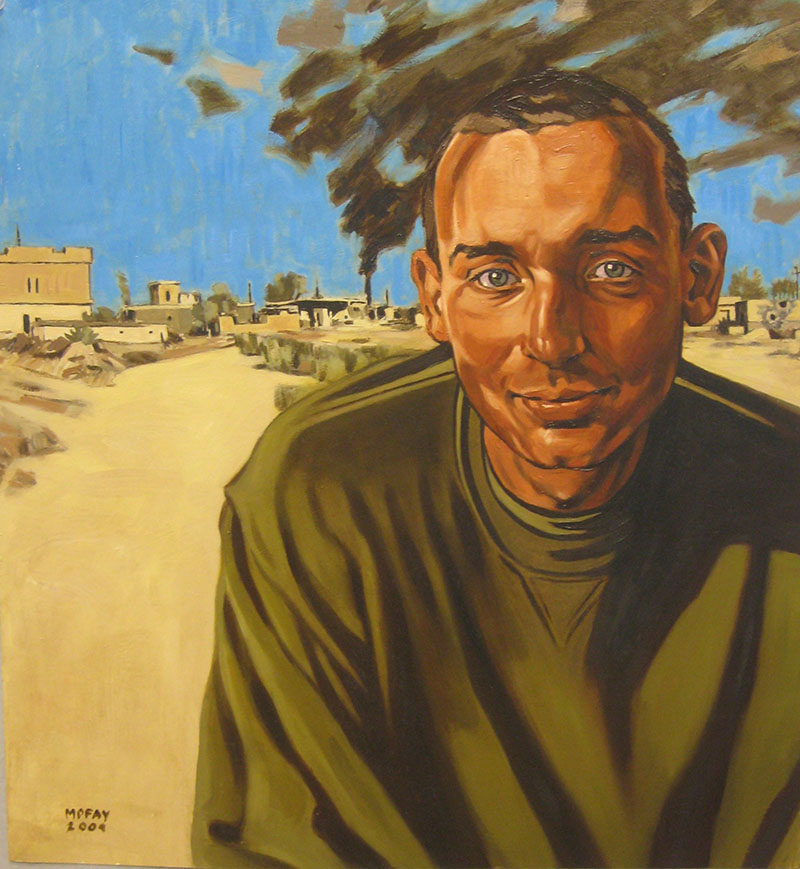
“I was outside talking to Rogers, and I asked him where the Lieutenant was,” Mooi remembered. “I didn’t realize that he never came back out. I knew I had to go get him, so I went back inside. That was the last conversation I had with Rogers.”
Mooi pushed back into the house on his own and located McGlothlin lying mortally wounded from grenade shrapnel and machine-gun bullets. As he neared a stairwell leading to the roof, Mooi encountered an insurgent standing on a landing, throwing grenades over the roofline into the courtyard. Before the enemy could react, Mooi shot and killed him. As Mooi dragged McGlothlin out the front door, he discovered that in the time it took him to kill the insurgent and remove McGlothlin, Rogers had also been shot and killed. The scene outside the house juxtaposed absolute chaos with astounding heroism, as wounded Marines and corpsmen treated and packaged for evacuation others who were more wounded than themselves.
Simultaneously, 2nd Squad walked behind a line of tanks several hundred feet away, advancing toward the farmhouses. The tanks throttled up and bolted toward the enemy fire when the ambush kicked off. 2nd Squad sprinted behind the last tank, trying to keep up. Tiny explosions impacted the dirt around them as they ran from insurgents targeting the Marines. The last tank finally stopped, and the Marines took cover. Cpl Javier Alvarez, the 2nd Squad leader, picked up the phone on the back of the tank and directed the crew to put a main gun round into the house where the enemy fire originated. The Marines plugged their ears as the 120 mm cannon roared. They trudged alongside once again as the tank rolled out, enemy rounds still cracking through the air.
“I was focused on engaging the area next to us where a lot of enemy fire was coming from, so I wasn’t paying attention to the radio to know what was going on,” Alvarez remembered. “Someone told me to have the tank put another main gun round into the building in front of us, only about 40 feet away. I relayed that to the guy inside the tank, and he said he couldn’t because there were friendlies inside. I looked around the side and saw Cpl Rogers down injured next to the building. There were insurgents popping out and shooting at us and our machine guns were engaging them. It was really close. I had been in my own world and had no idea what was going on in that house. It was chaos.”
Alvarez organized his squad and sprinted across the open area between the tank and the house. He emptied one magazine into the windows and reloaded as he ran. Abrupt punches across both his legs stole his attention. Bloodstains on his trousers rapidly increased in size, flowing from multiple gunshot wounds. Somehow, the injuries failed to take him down. He inserted a fresh magazine and continued sprinting until he fell against the side of the house beneath an open window. Seated upright with his back to the wall, Alvarez spread his legs out in front of him. Multiple bullets tore through both thighs and his left calf, each wound bleeding steadily.
A Marine pulled tourniquets for both of Alvarez’s legs. As he placed them high on Alvarez’s thighs, an insurgent appeared in the window above them and shot the Marine in the head. The round struck off his helmet, knocking him to the ground between Alvarez’s legs in a daze. Alvarez lifted his rifle and emptied another magazine into the window.
“I brought my rifle down to reload and was looking off to my right,” Alvarez said. “When I looked back down, I saw a grenade rolling around next to me. There were friendlies inside, a stacked team in front of me, a Marine behind me, a Marine in between my legs; instantly I just thought, ‘I need to get this away from us.’ So, I picked it up and tried to throw it away, but as I turned to release it, it detonated.”
The explosion went off an arm’s length above his head, causing Alvarez to black out. He came to seconds later and im-mediately felt his hand burning. When he raised his arm, he discovered the hand was completely gone. The Marines around him lay wounded by the blast. Homer ignored his own injuries and ran up to Alvarez, placed a tourniquet on his devastated arm, and assisted him to the casualty collection point (CCP).
Hospital Corpsman Third Class Jesse Hickey accompanied 2nd Squad up to the house. He immediately went to work treating the wounded Marines piling up outside. The insurgent inside lobbing grenades over the roofline maintained a steady barrage until Mooi finally pushed through the house and killed him. Hickey, Homer and numerous others suffered wounds upon wounds as the explosives detonated.
“It was just grenade after grenade after grenade,” remembered Jendrzejczyk, who also made the dash under fire with Alvarez’s 2nd Squad. “Me and Doc Hickey carried Rogers’ body to the collection point, then went back to grab Lucente. When we went to pick him up, a grenade came out the window and Doc took all the shrapnel from that. Now, he’s there trying to bandage himself while I’m trying to bandage Lucente. It was just absolute chaos.”
“Our other platoon corpsman, Doc Eric Rust, had almost the same wounds as me,” said Sanbeck. “He took a grenade to the legs while he was bent over working on somebody. Our corpsmen were just remarkable. We called them, ‘Devil Docs’ because they were really just Marines with band-aids. They aren’t supposed to be in the fight like that, and yet here is Doc Rust shooting his 9 mm pistol with one hand and putting a tourniquet on with the other. I don’t think anything in medical school prepared him for that.”
Lance Corporal Roger W. Deeds served as a machine-gun section leader attached to 2nd Plt. As Marines began to fall in and around the house, Deeds handed off his machine gun to another Marine and sprinted forward to help. He assisted the corpsmen treating the wounded and prepared them for evacuation. Like so many others, Deeds responded when the platoon sergeant called for help. He remained exposed outside the house providing covering fire until he too was mortally wounded.
Homer crossed the deadly 25-yard kill zone between the house and the CCP numerous times, moving casualties away from danger. Grenade shrapnel stitched across his side, leaving him severely wounded, yet he refused to join the others piling up at the CCP. Mooi eventually found Homer at the CCP after they both helped evacuate separate casualties to inform him Lt McGlothlin was dead and Homer was now in command.
After evacuating Lucente, Jendrzejczyk realized he was the most medically trained Marine available at the CCP.
“I had gone through advanced combat lifesaver training in Egypt before we flew into Iraq,” he said. “That probably helped me the most. I threw down my rocket and was able to help the corpsmen because nobody else was really trained, and both corpsmen had been hit. There were enough rifles around that I didn’t need to go out there and fight the fight. What I needed to do was help with the mass casualty [situation], so I focused on the CCP and trying to get all these wounded Marines to the medevac bird while the fighting was still going.”
Mooi returned to the house once again, following his conversation with Homer. After watching his entire squad wiped out in the fighting, Mooi determined to personally finish what they had started.
“I decided, it took all of them, so it was either going to take me, too, or we were going to win this,” he stated. “At the time, I’m a 19-year-old infantry Marine; like, I thought I was untouchable. I ran back to the house and took point on a mixed team from 2nd Squad. Someone passed me a hand grenade because I didn’t have one. I tossed it inside, then went back in.”
Several Marines followed Mooi as he led back through the house clearing room by room. They engaged more insurgents, eventually arriving at the back door. Mooi burst into the light with his rifle shouldered at the ready.
“We came rolling out the back door into the yard. There was a pile of fuel barrels right there, and a guy with a machine gun lying next to them. I turned and fired a couple rounds at him as he turned and fired a couple rounds at me. I don’t know if I hit him, but he definitely hit me. I am the luckiest person in the world. Three of the rounds he fired hit my rifle magazine and did not go through. Another round hit the upper receiver and got stuck in the bolt carrier group. That all would have been in my neck and face. I went to fire again and realized my rifle was down, so I rolled back to try to get back inside the house. The Marine behind me opened up and was able to kill the insurgent.”
By the time Mooi and the Marines from 2nd Squad finished clearing the house, the majority of casualties outside were moved to the CCP. First Squad arrived from their supporting position to assist with the casualties.
“Everything was happening so fast,” VanHout said. “So fast it really kind of rocked us. We cleared through our house and got onto the roof, then we got the call over the radio about the mass casualty incident and immediately moved down and were trucking back along the stone wall towards the CCP. As we were coming back that trail, that’s the first time all of us in 1st Squad saw one of our casualties coming out of the battle the rest of the platoon was in.”
“We got to a little break in the wall and I saw a Marine dragging another body,” Studzinski remembered. “I realized the person he was dragging was wearing our cammies, then saw the name tape on his back and it was Ware. Then I turned towards the building where all the fighting was going on and saw Cpl Rogers’ body leaning up against a pillar of the carport parking area. Lt McGlothlin was lying nearby, and I could see in his face that he was dead as well. We moved towards the CCP and as soon as I was about to go through the door, I saw another Marine lying face down. I saw the name tape on the back of his Kevlar and it was LCpl Deeds. The first thought that immediately came into my brain was that he just had a daughter born while we were on ship. I went inside and saw Cpl Alvarez with a chunk out of his leg and his hand looking like a fist full of spaghetti. I went into another room and saw Lucente laying on the ground with Jendrzejczyk and Doc Hickey working on him, while another Marine was working on Doc Hickey because he was wounded too.”
“By that point, most of the combat in that main house was over, and we were already starting to get Blackhawks in for medevac,” VanHout added. “I don’t know what adrenaline was doing to the timespan, but this was only a matter of 15 or 20 minutes. I remember seeing Lt McGlothlin at the CCP leaned up against a wall with a poncho liner over him, half blown off by the breeze. It was the most surreal moment of my life. A couple of us went to him and started getting him ready to go on the helicopter. We brought him to the chopper, and I thought I was watching a scene from ‘Apocalypse Now’ or something, with blood running out of the bird and down over the skids. I just couldn’t believe it. But, we loaded him up and I just turned around and went back looking for the next guy.”
While 2nd Platoon’s battle raged inside the house, the Fox Company command group set up on the roof of a three-story building nearby. Captain Ross Parrish, Commanding Officer, Fox Company, ordered a 100-round fire-for-effect mor-tar mission into the palm grove beyond the house. Numerous enemy fighters fleeing the buildings were cut down in the trees by falling explosives. Standing next to Parrish, Capt Brian Gilbertson masterfully worked the radio coordinating air support. A C-130 transport pilot by trade, Gilbertson attached to Fox on the deployment as their forward air controller. Less than 30 minutes after the shooting started, he had U.S. Army and Marine Corps helos on the ground evacuating casualties. Simultaneously, he vectored in Cobra gunships from Marine Light Attack Helicopter Squadron 369, pouring rockets into the palm grove.

“We reconsolidated at the command post after clearing the house,” said Mooi. Miraculously, he emerged from the ferocious firefight without a scratch. “There was stuff going on all around that building now; tanks shooting main gun rounds into it, helicopters flying all around doing gun runs. There was a mortar team on the roof at the CP just letting it rain down into the palm grove where the remaining bad guys were at. It was beautiful. We were at the point where all the support weapons are doing their job, so all the ground guys kind of slowed down. That’s when everything really started to sink in, and all the adrenaline started to fade.”
The fighting lasted less than an hour. The house where 3rd Squad encountered the insurgent stronghold partially col-lapsed under a barrage of tank main gun fire. Thousands of bullet holes, scorch marks, and spalling marred the outside walls. The BLT remained in Ubaydi for three more days patrolling around the same area. At some point, a grunt began scrawling tally marks on one of the buildings counting the enemy dead who lay where they fell. By the time the battalion departed, the tally reached 57.
Operation Steel Curtain closed successfully achieving its goal. The Marines of 3/6 remained in Al Qa’im to oversee the elections. BLT 2/1 pulled out of the region to the city of Hit, where they remained through Christmas. After the new year the battalion returned to their ships, and the 13th MEU sailed home.
Fox Co’s 2nd Platoon completely disintegrated in the aftermath of Nov. 16.
“We went into Ubaydi with 43 Marines,” said Jendrzejczyk. “Only 17 of us walked out. That changed all of us forever.”
The survivors amalgamated into other platoons, left to wonder how many of their brothers fared after disappearing from the battlefield on medevac helicopters. The wounded dispersed through hospitals across Iraq, Germany and eventually the United States, all of them only later learning the full extent of what happened to their platoon.
Sanbeck underwent his first surgery to save his legs while still in Iraq. Despite the heavy dosage of morphine coursing through his bloodstream, doctors made him sign a waiver stating he understood they might have to amputate both lower limbs. As more casualties from the battle arrived, Sanbeck overheard someone listing the Marines who had been killed. Only then did he understand how devastating the ambush had been.
Alvarez woke up in a hospital in Germany with burns across his face, eardrums blown, shrapnel throughout his body, four gunshot wounds in his legs, and his hand completely gone. He went unconscious and was intubated during the flight to Bethesda, Md., where his long road to recovery began. Alvarez’s rapid evacuation immediately severed him from contact with his platoon. Without any telephone numbers or an account on social media, Alvarez struggled to reconnect with the remainder of 2nd Platoon.
Capt Parrish undertook the monumental task of piecing together the ambush in the weeks following Nov. 16. On the voyage home, he asked his Marines to write witness statements detailing their individual points of view. The resulting picture of the battle revealed the awesome depth of selfless heroism exhibited by many Marines that day. Parrish next determined to ensure his Marines were appropriately recognized and worked with his staff to author citations for individual medals.
“November 16th is certainly an exception from my 30 years in the service,” Parrish reflected today, now a colonel still on active duty nearing retirement. “It’s what we train for, but those kinds of high intensity, close quarters engagements don’t occur that frequently. Those Marines fought like lions. I couldn’t be more proud of them. When fatigued, when under duress and under fire, with an enemy that has you ambushed, they flipped the script with their level of proficiency, professionalism and violence.”
The awards churned slowly through the Corps’ bureaucracy. After three years, Robert Oltman, the commanding officer of BLT 2/1 during their time on the 13th MEU, received promotion to colonel and a transfer to Marine Corps Base Quantico, Va. Oltman never lost sight of his Marines from 2/1 and those who died in Iraq. He regularly drove across base to the awards branch to inquire on the status of the awards. He became a persistent visitor, personally ensuring the packages for each of his Marines worked through the system.
“There were a lot of heroes that day that nobody knows about,” Oltman said. “So many Marines did so many extraordinary things that allowed more people to come home than may have, had they not taken the actions they took.”
Joshua Mooi left active duty in August 2008 and returned home to begin civilian life around Chicago, Ill. That fall, he received a call informing him the Marine Corps had awarded him the Navy Cross, a medal for valor second only to the Medal of Honor. He flew to Camp Pendleton, Calif., the following January, where Oltman proudly presented him with the medal. Mooi did not stand alone. Homer, Alvarez, and Doc Hickey shared the stage, all receiving Silver Stars. The family of Lt McGlothlin came forward to posthumously accept a Silver Star on his behalf. Numerous others received Bronze Stars with combat distinguished devices, including Lucente and Deeds recognized posthumously. Additionally, Oltman pinned Navy and Marine Corps Commendation Medals with combat distinguished devices on Marines such as Jendrzejczyk, and Navy and Marine Corps Achievement Medals with “V” on many others like Sanbeck. Still more came forward to receive a Purple Heart.
“I had it all written down at some point because it was just mind-blowing how many citations and commendations were awarded,” Sanbeck remembered. “When we had that ceremony, more of Fox Company went forward for some kind of award from Col Oltman than not. Here are all the young guys in the battalion looking at us like, ‘Holy cow, these are the guys training us now.’ It reminded me of when I came to 2/1 and all my seniors were receiving awards for things they did in Fallujah.”
The passage of 20 years has done little to dull the memory or pain of Nov. 16. For the Marines of 2nd Platoon, the awards they received serve as a persistent call to memory of the brothers they lost.
“I have carried that day with me ever since,” said Jendrzejczyk. “The guys who were there, we very rarely talk about it. What we lived through wasn’t just combat. It was hell. Through it all, we forged a bond that it doesn’t matter the distance or the time that goes by, nothing is going to erase that. We all know Steel Curtain is still there, and if we are struggling and need to talk about it, we can. We always try to remind ourselves that we need to live a life that they would have been proud of.”
“We all live for who we lost and try to do them proud,” echoed Sanbeck. “We were so young and everything happened so fast. I don’t think a day goes by that I haven’t thought about them or that I haven’t made a decision based on that. I think early on, a lot of us didn’t want to have fun in life because we had guilt and felt like you shouldn’t enjoy life. A lot of us were mad and angry at the world for losing what we had and trying to fit into ‘normal’ civilization with no one understanding and listening to people complain about such simple, meaningless things. Now, I think it’s more of a mentality where a lot of us feel like, ‘You know what, they wouldn’t want us to live like that.’ Not everyone can just make that shift, but for me, I don’t leave any rock unturned in life now. If there’s something I can go do and enjoy it, I’m going to go do it. It’s time to take ahold of life, because that’s what they would have wanted us to do.”
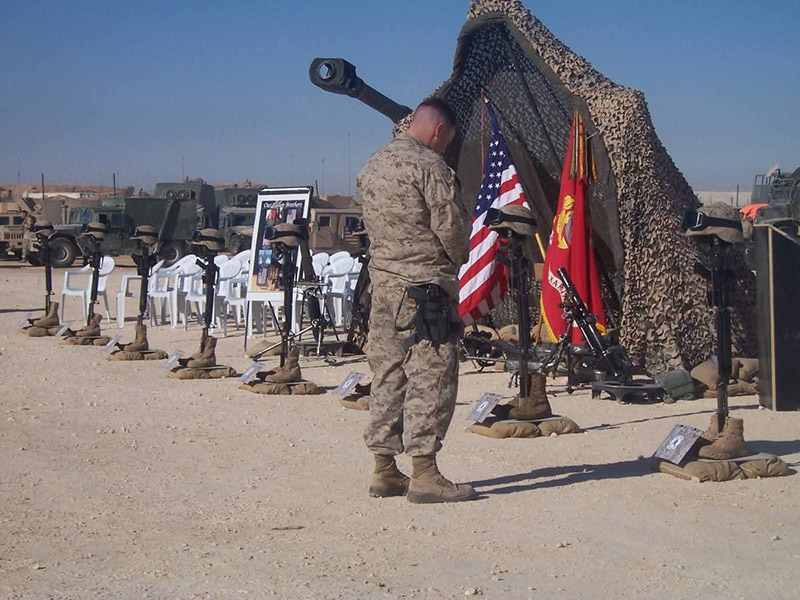
“Sixteen November: The Line Held”
By Devon Wilfong
In eternal memory of:
2ndLt Donald R. McGlothlin
Cpl Jeffry A. Rogers
LCpl Roger W. Deeds
LCpl John A. Lucente
Cpl Joshua J. Ware
The sun rose slow on foreign sand,
Where war had scarred the
river’s hand.
Fox 2/1 moved house to house,
Through Ubaydi’s deathtrap, silent,
doused.
They knew the risk, they knew the cost,
Each man beside them worth more
than lost.
Then thunder broke from
walls unseen—
An ambush split the desert scene.
No time for fear, no room for doubt,
Just fire and smoke and shouted route.
The alley screamed, the rifles spoke,
And every breath drew heat and smoke.
They fought with grit, they fought
as one,
Five lives were taken before
day’s done.
But not before their courage roared—
Their names now etched in
Marine Corps lore:
2ndLt Donald R. McGlothlin, bold,
Who led them straight into the fold.
Cpl Jeffry A. Rogers, fierce and fast,
Who stood defiant to the last.
LCpl Roger W. Deeds, unshaken,
proud,
Who faced the storm and never bowed.
LCpl John A. Lucente, sharp and true,
At just nineteen, he saw it through.
Cpl Joshua J. Ware, all heart and fire,
Whose will outlasts the gunman’s ire.
They did not run. They did not bend.
They held the line until the end.
And though they fell on foreign ground,
Their echoes in the Corps resound.
So raise your glass and say their names,
Not lost to time, nor war’s cruel games.
For they remain in memory sealed—
On Sixteen November, the line held.
Author’s bio: Kyle Watts is the staff writer for Leatherneck. He served on active duty in the Marine Corps as a communications officer from 2009-13. He is the 2019 winner of the Colonel Robert Debs Heinl Jr. Award for Marine Corps History.
Featured Image (Top): 2nd Plt, Fox Co, BLT 2/1, entered Ubaydi on Nov. 14, 2005, with 43 Marines. When the operation ended a few days later, only 17 walked out unscathed. The survivors are pictured here preparing to leave the city. Then-GySgt Michael D. Fay accompanies the platoon in this photo, leaning on the truck door in the foreground.


